Metalworking - 2015, part two: welding, roboruki, manipulators, tumbling
And again, in our blog, a report from the Metalworking Exhibition-2015 - the largest exhibition dedicated to machines for various types of metal processing. 32 countries, more than 900 exhibitors, of which 400 are Russian companies, thousands of machine tools, hundreds of tons of metal, liters of emulsion and kilograms of chips. It was fun!

This time we visited all 7 pavilions, and therefore one part, along with gifs, weighs almost 50 megabytes.
Comrade! Be careful with the traffic going under the cat!
')
This is the second part of the article. Read the first part here.
So, we continue.
In the process of metal processing, waste arises - metal shavings and spent coolant. And for this and for the other, there are solutions - compactors for chips:
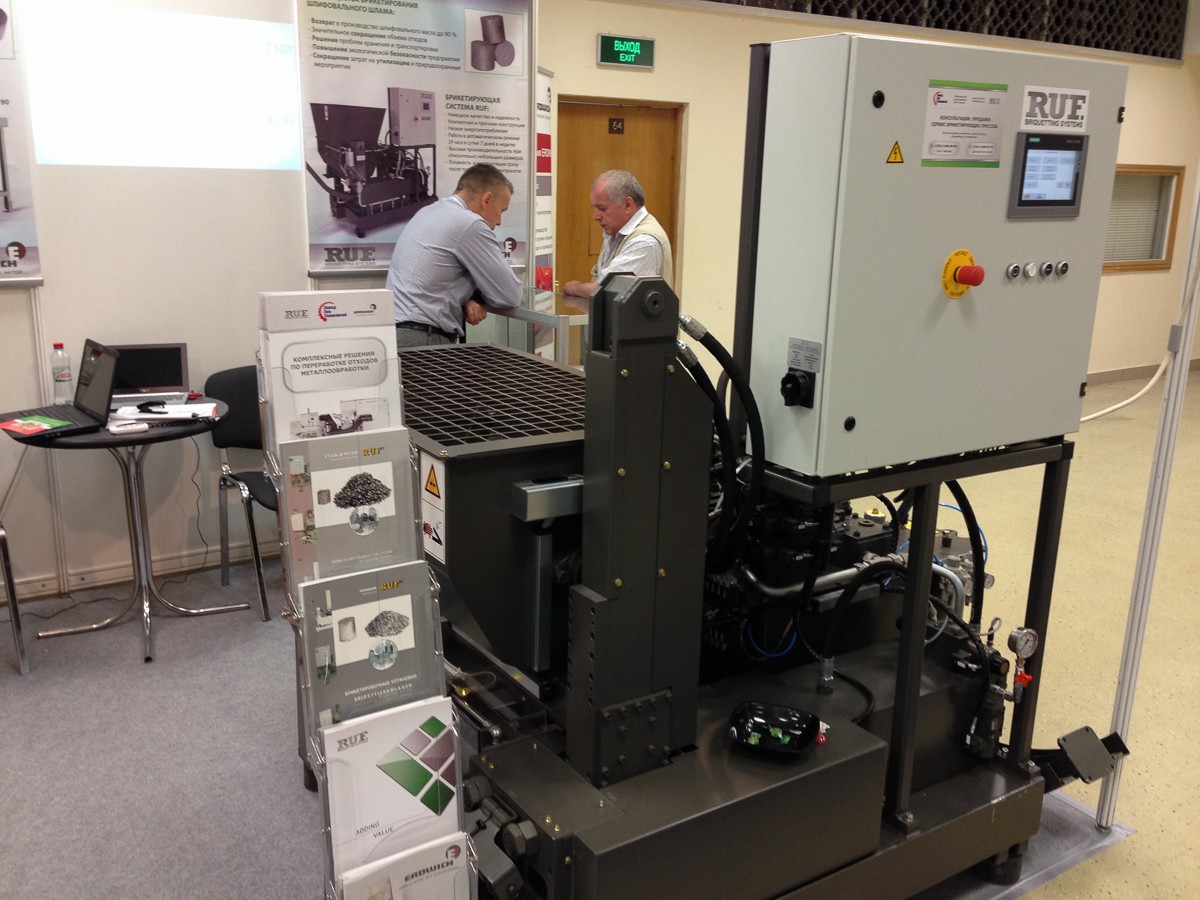
Which make it such nice metal pills:
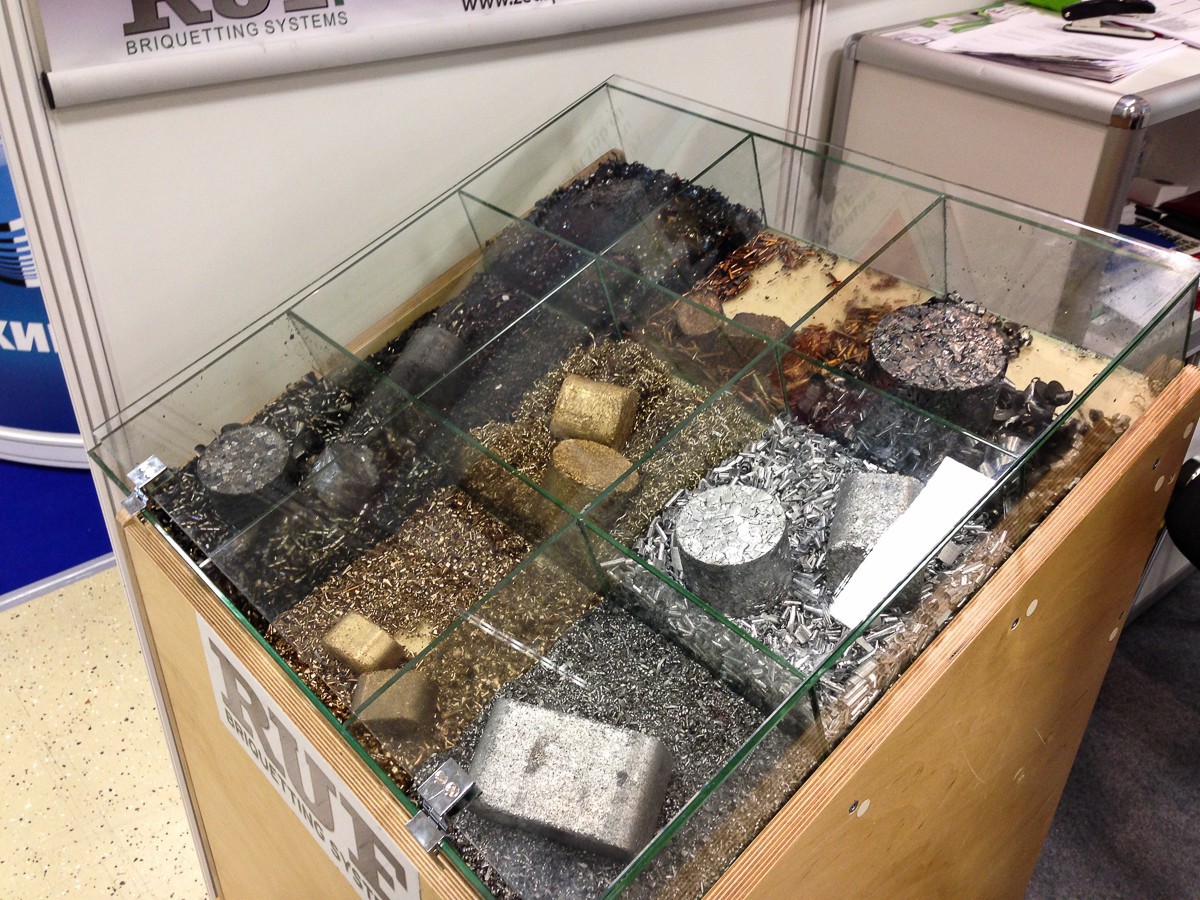
And liquid cleaning stations that allow you to reuse water from anything, rather than waste it:
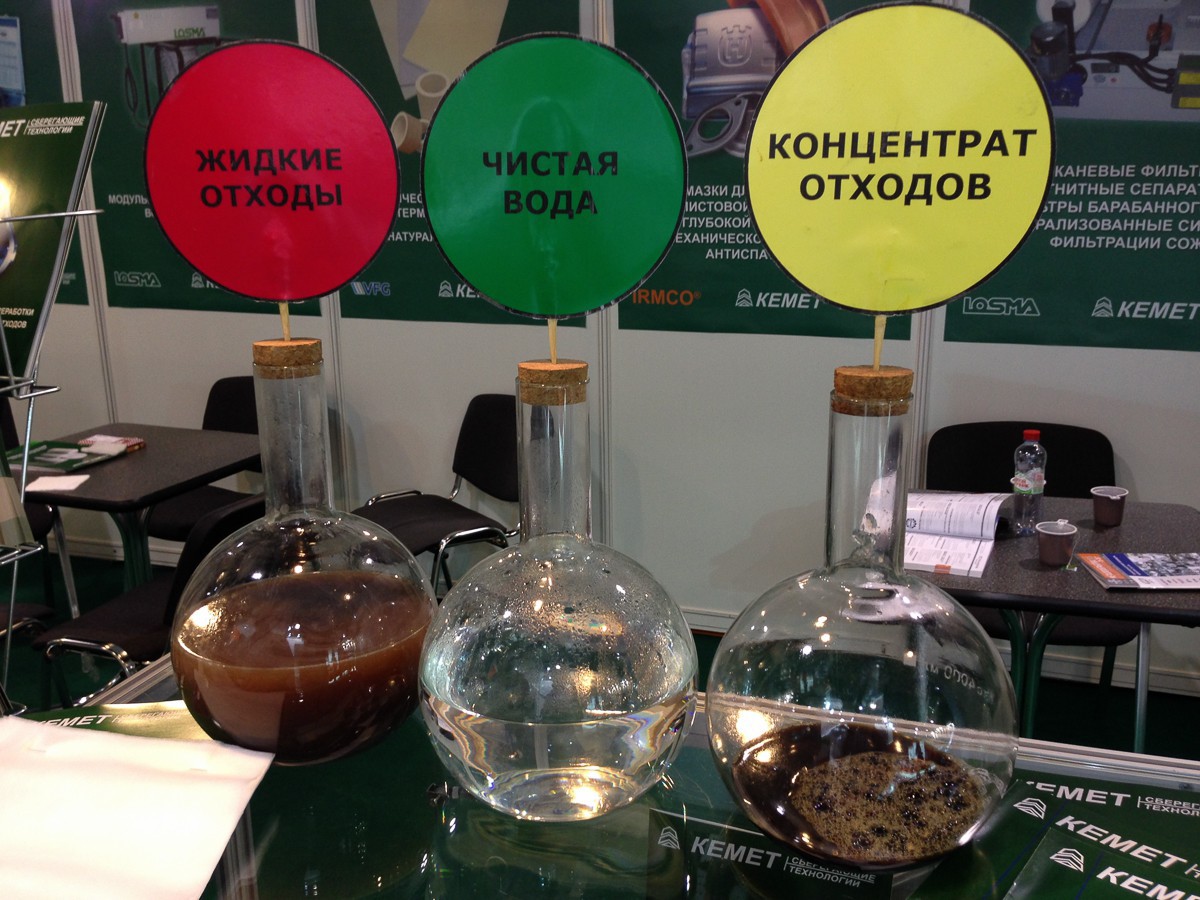
You can also reduce the amount of waste - for example, using an airborne lubricant:

This automatic machine mixes oil with air and, under pressure, supplies it to the processing site, seriously reducing oil consumption and improves cooling.
But a fun simple mechanism that serves to collect oil films from the emulsion surface:
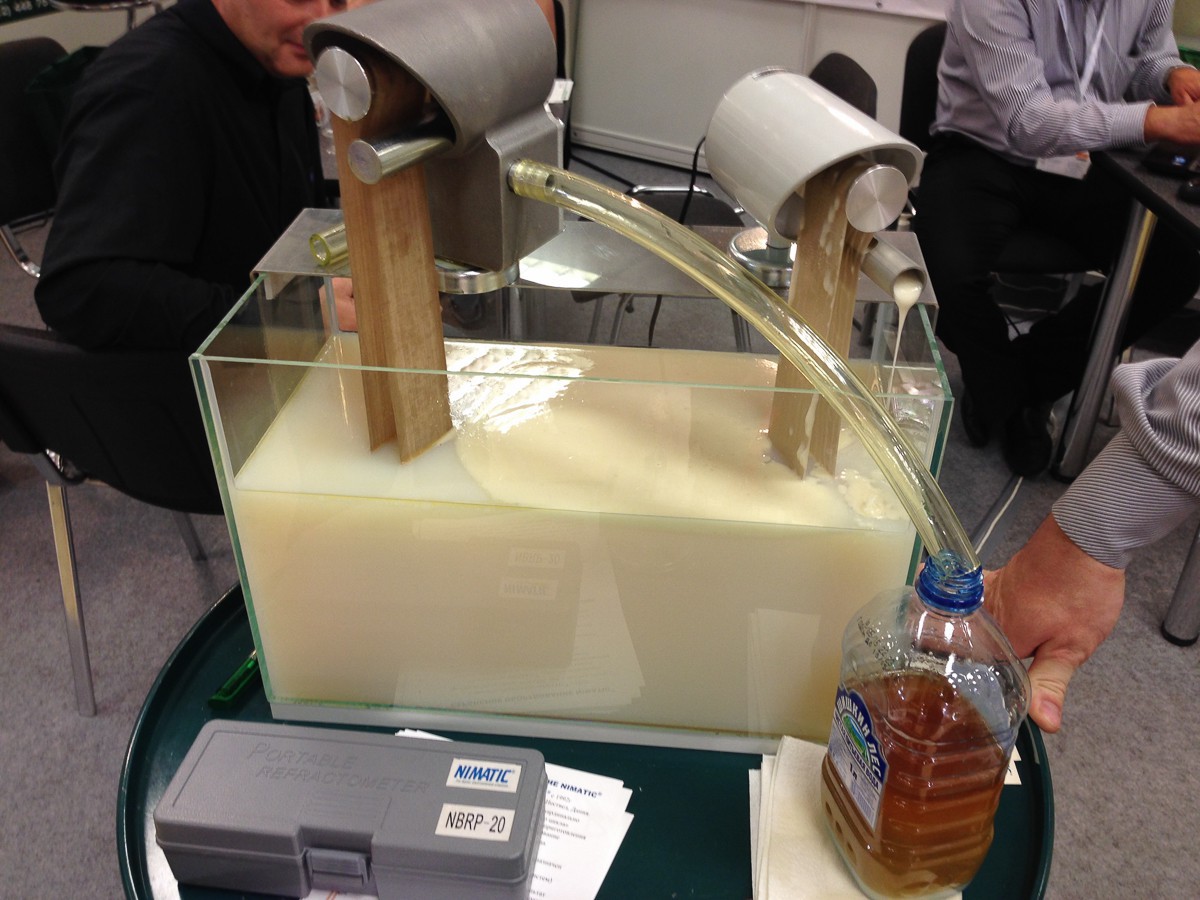
It is based on the fact that a cloth glued into a ring, slightly wetted with water, but well - with oil, is continuously pulled through the emulsion. When the canvas passes through the layer of oil, it sticks to the surface, and at the top it collects from it with a sharp edge and flows by gravity into the oil compartment. Simple and elegant.
Now let's talk not about cutting, but about the connection of metal. For example, about welding. Here, for example, automatic machine for pipe welding:

How to cut the pipe, I already showed you. And this is how they are welded:
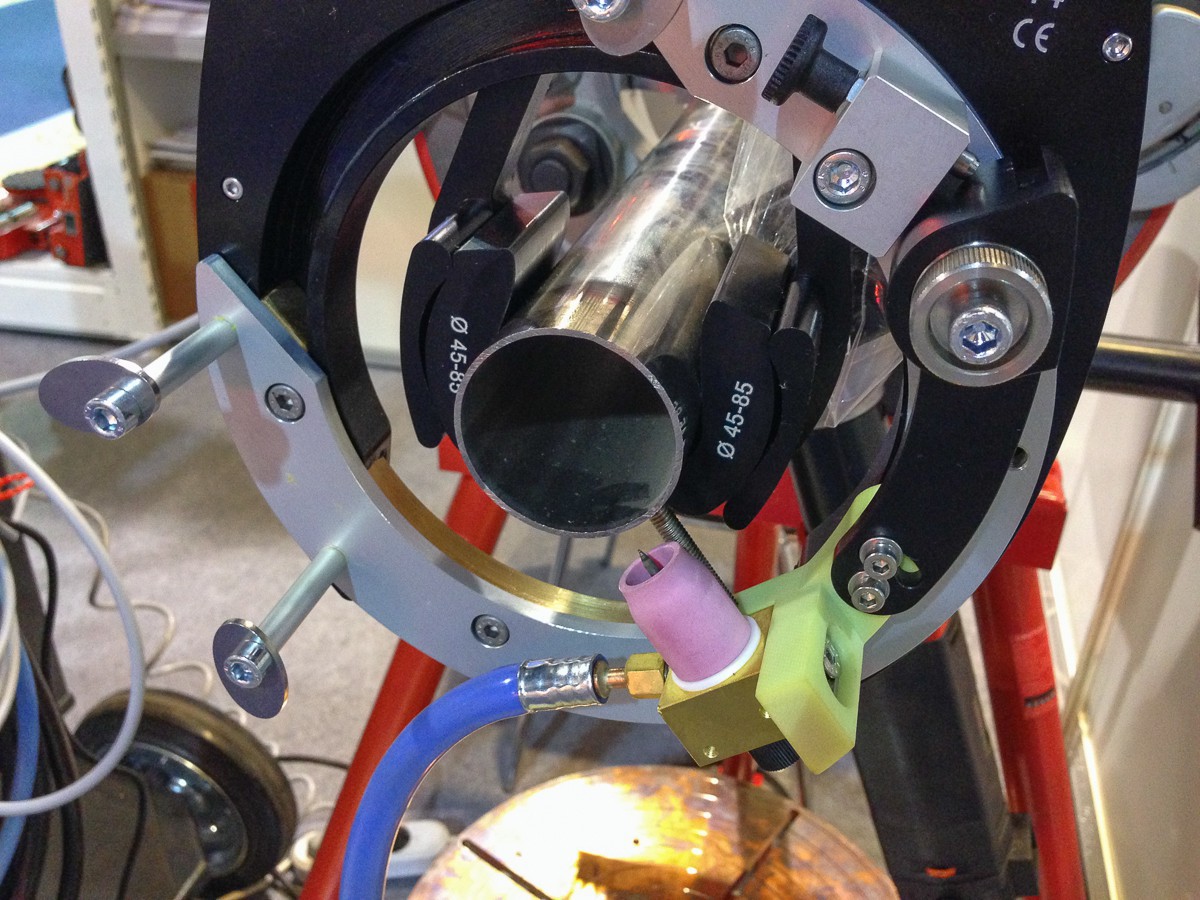
If the pipe is so large that there is no possibility to locate the machine around it, or if it is not a pipe, but just a curved part, then the Sunrise automatic welding kit comes to the rescue:
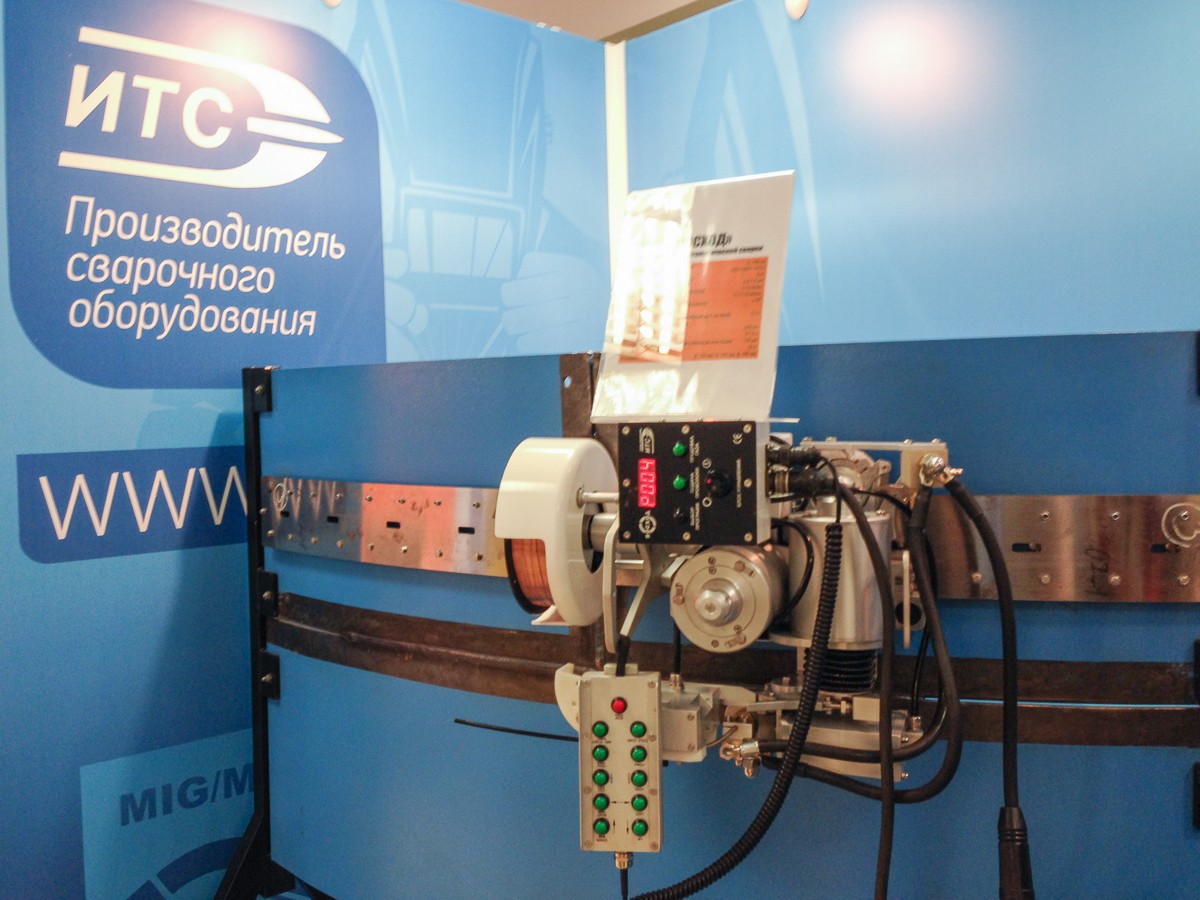
It is attached to the surface with magnets (or with the help of vacuum suction pads for non-magnetic materials):
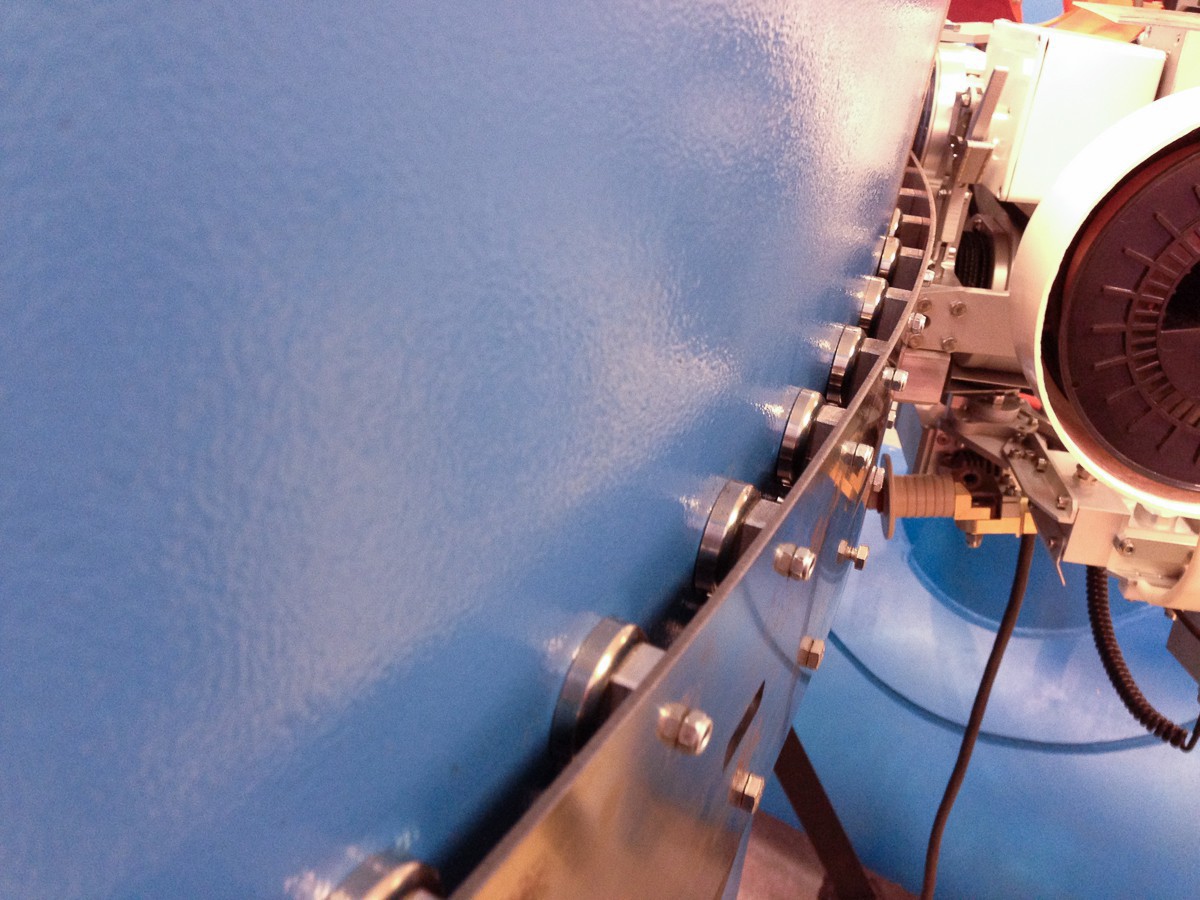
And absolutely automatically (including transverse movement along the seam and axial oscillations of the burner) welds two parts:

It turns out such a beautiful seam:
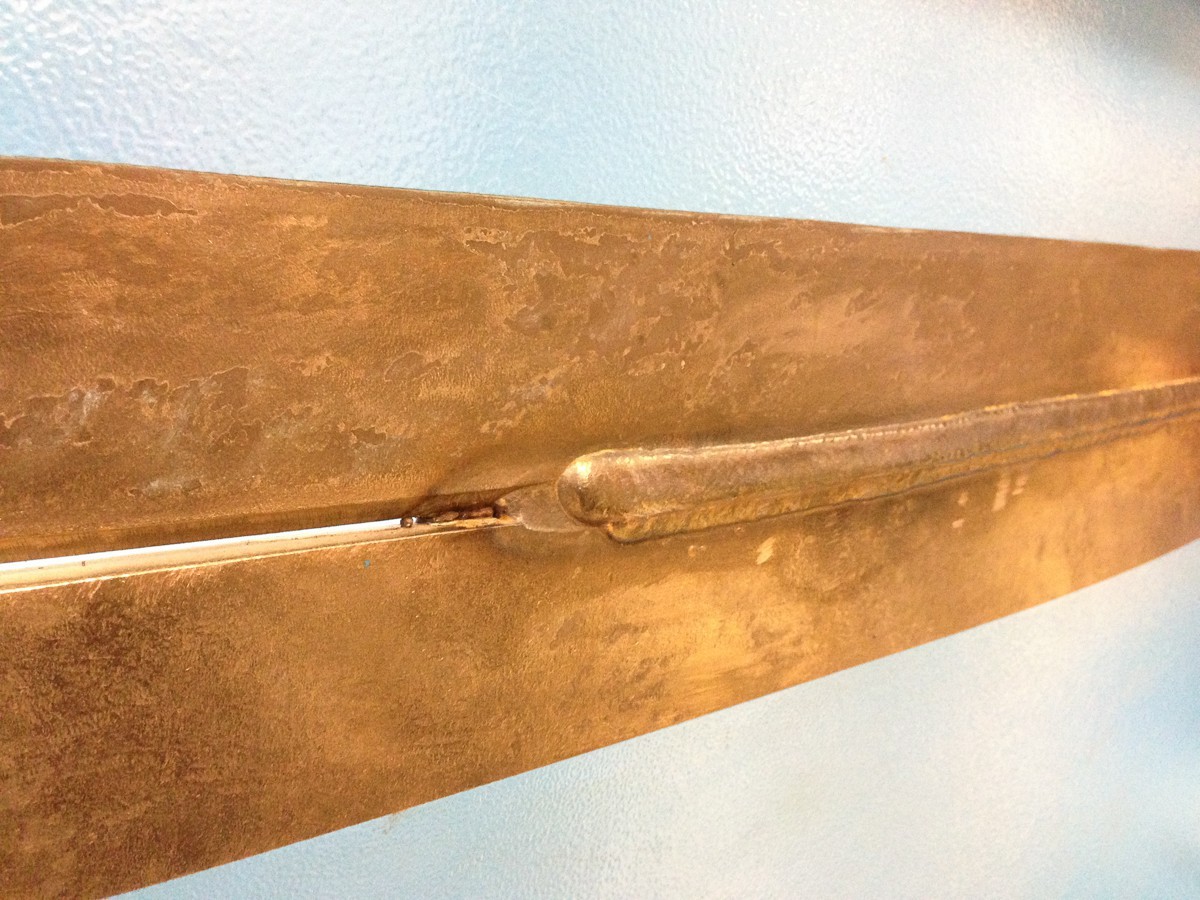
Of course, automatic welding machines were also shown:
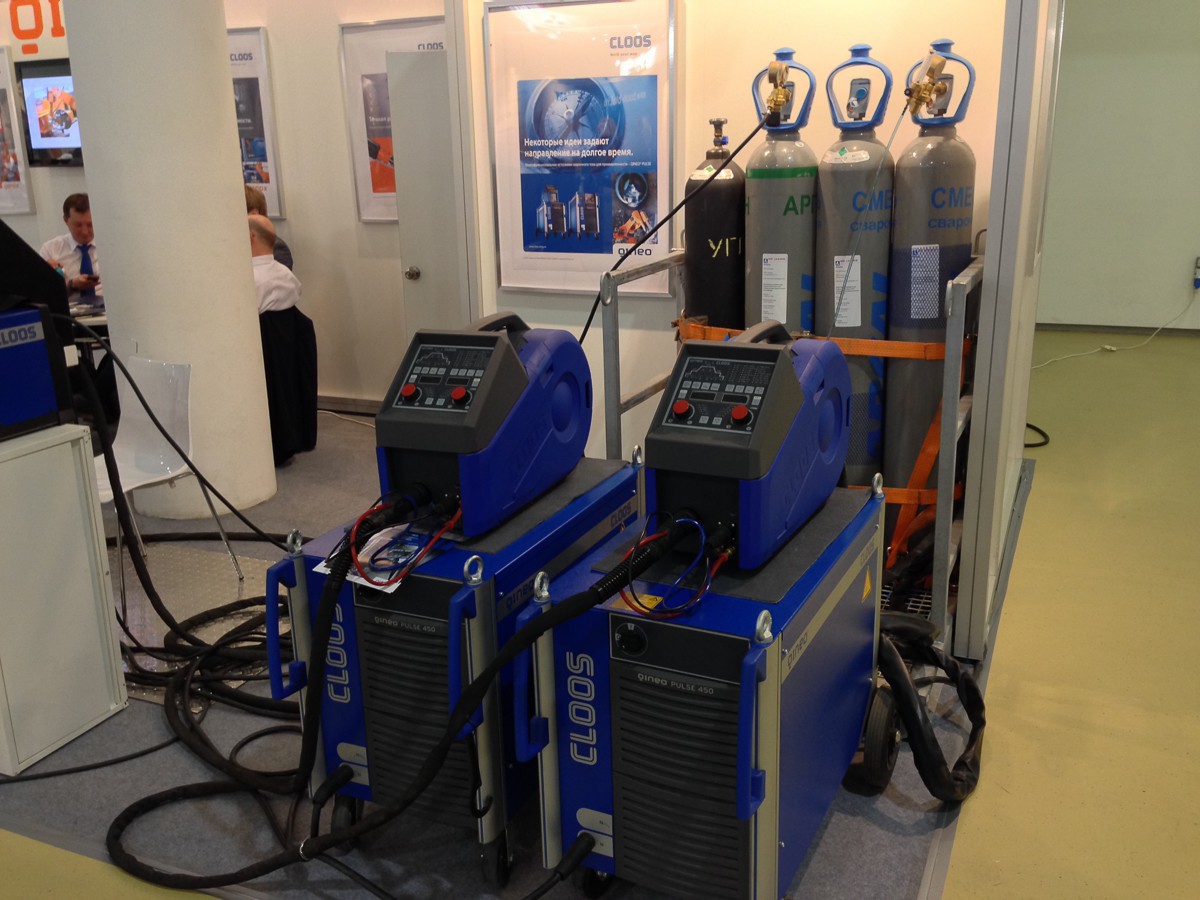
For example, these can boil almost any metal in any gas mixture:
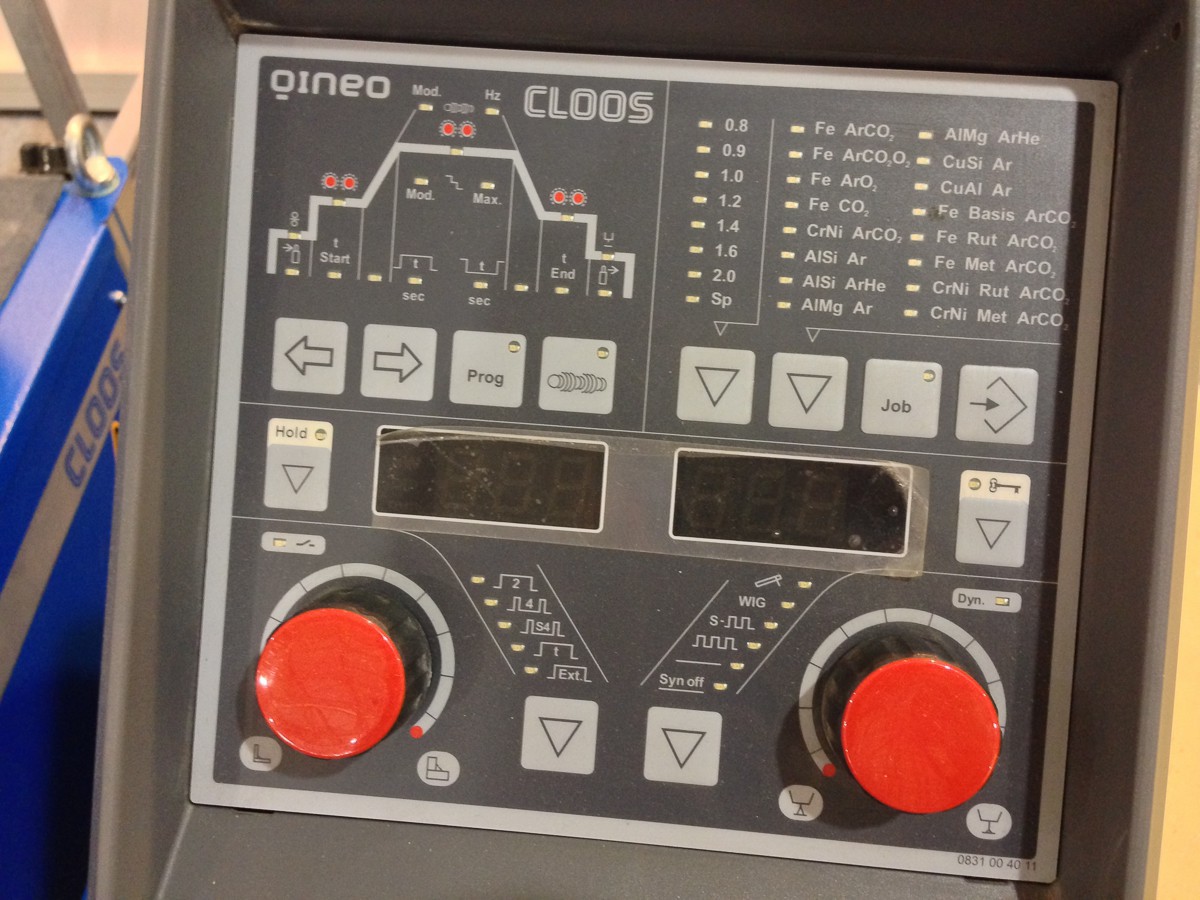
And this welder can weld bolts and nuts to metal surfaces:
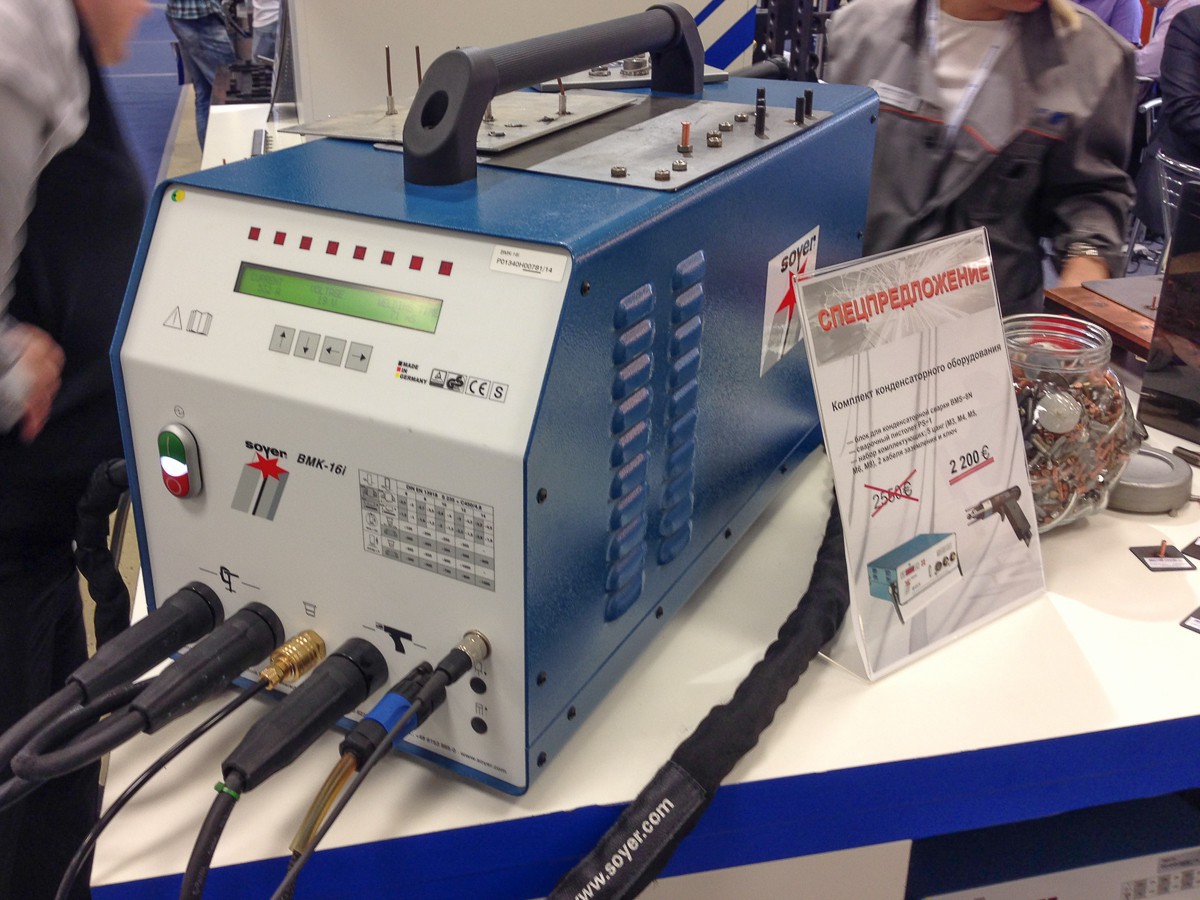
A special bolt is inserted into the working head (it is distinguished by an almost total absence of a cap and some kind of special coating):

The tool is pressed against the metal sheet and the button is pressed:
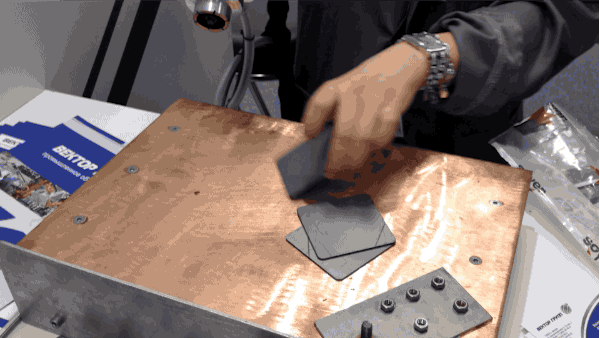
Here you can see what happened as a result:
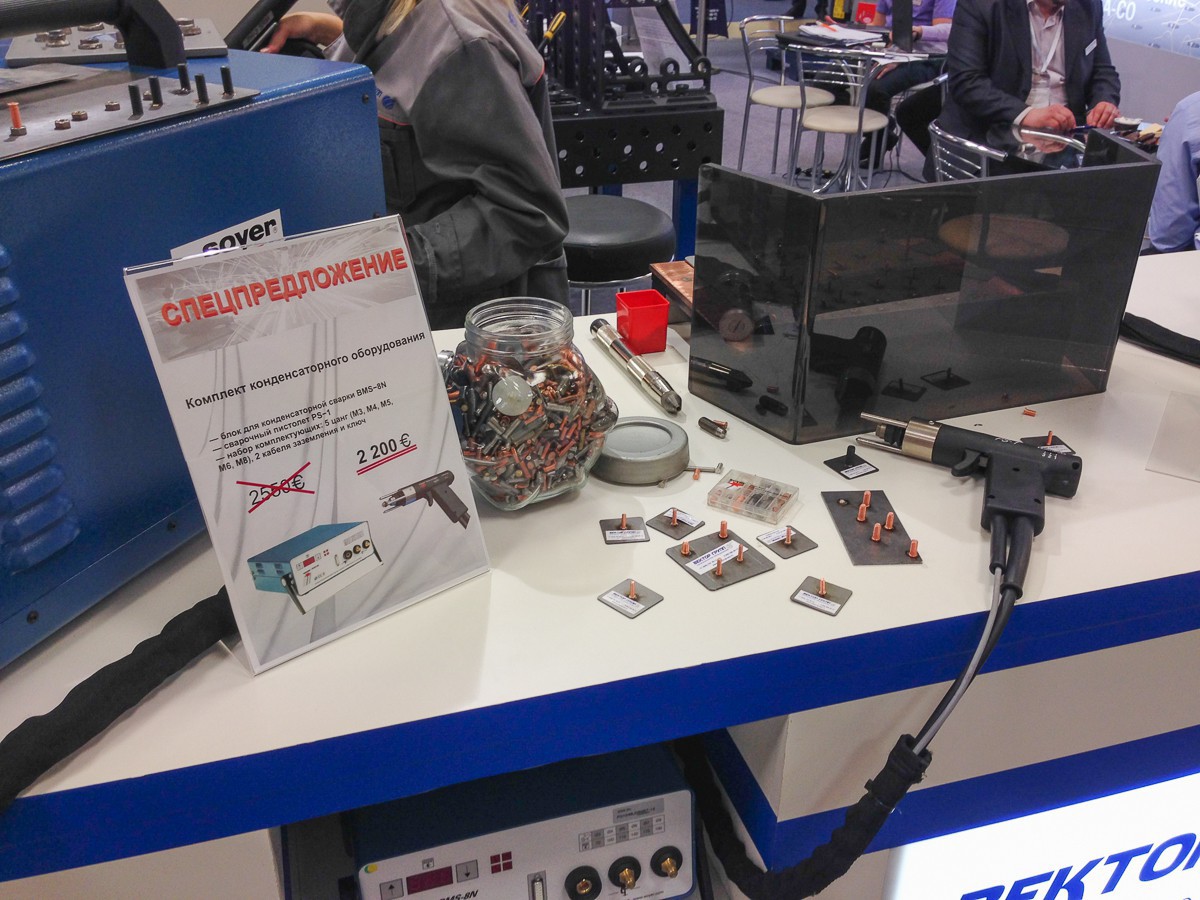
This is a device for proper sharpening of electrodes for argon-arc welding:
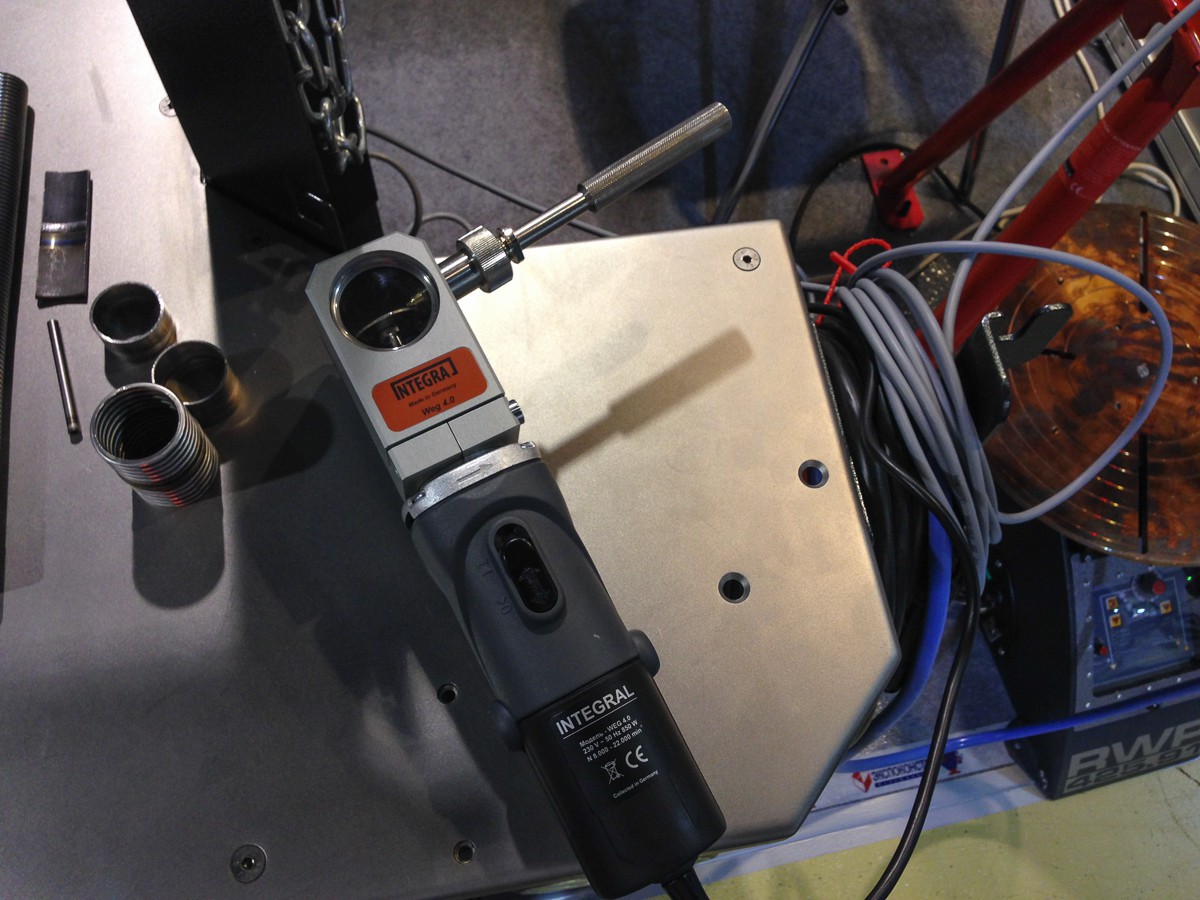
If amateurs get along with a screwdriver and a Dremel, then professionals use special devices in which the electrode is always sharpened at the right angle.

If a part is really a complex shape, then automatic welding is performed using one or several manipulators:

In general, manipulators can do a variety of things. Turn over parts:

Serve them:

Download to machine:
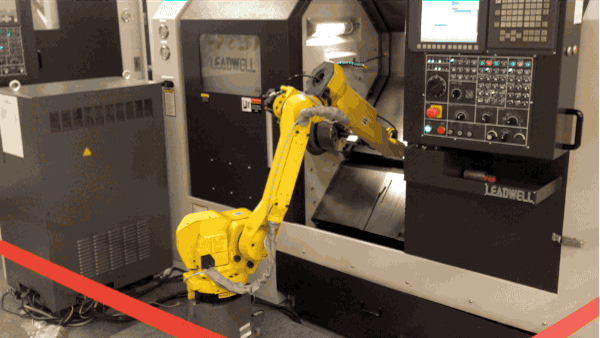
To mill complex shapes:
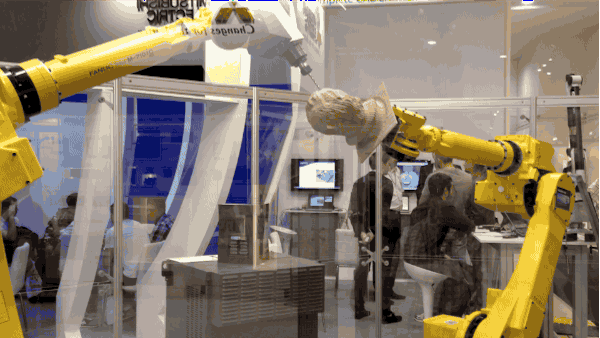
To play air hockey:

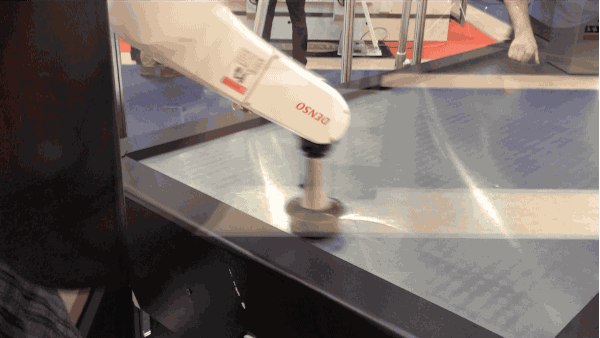
Pretend mime (you can watch the video here (by the way, subscribe ):

And even sort the details:
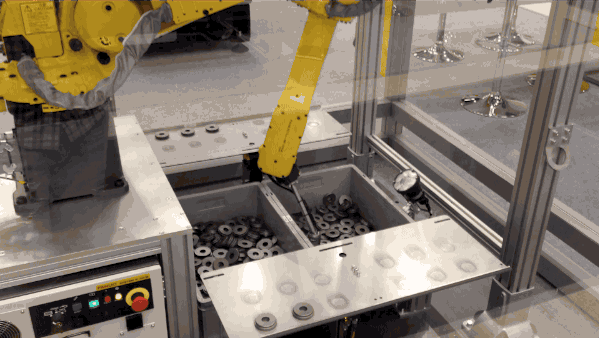
Here is the thing that puffs red - the camera, with the help of which the robot understands which side has the part turned to it, and depending on it puts it on one or the other side. Another camera with a special laser illuminator is located at the top - it is needed to determine the position of the piled parts, so that the robot can grab it correctly.
Another very interesting development of the same company is “High-speed robotic cell for sorting by color”:

It represents such a cute yellow machine that can automatically automatically identify objects of different colors on the working field and sort them according to color, and do it at a speed inaccessible to humans:

Once, once, once and ready:
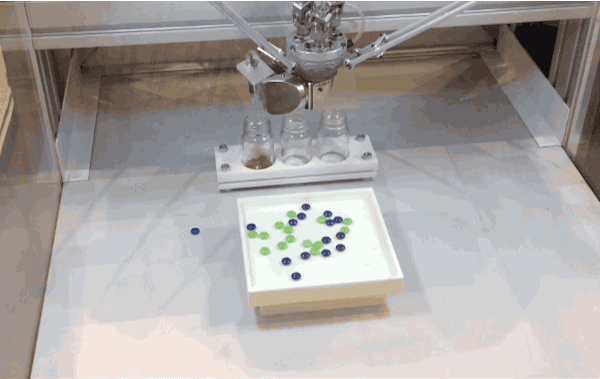
In fact, he does it faster than on the gif. The real speed can be seen here (by the way, subscribe ).
It clings and carries objects with vacuum suction cups:

After all three colors are sorted by jars, the robot overturns them back to the working field and everything starts anew:
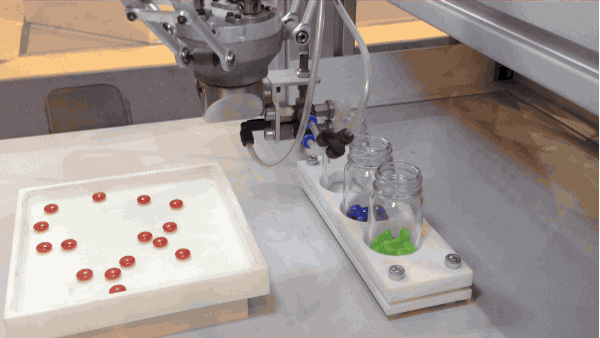
You can watch forever.
KUKA brought a friendly roboruku, around which there are no signs forbidding to approach it:

And the thing is that she somehow knows how to determine what is being prevented from working and stopping her movement. It looks pretty impressive - the dude comes up to the hand moving at full speed, it bumps into his shoulder and ... nothing happens - the push turns out to be sensitive, but not even knocking him down:
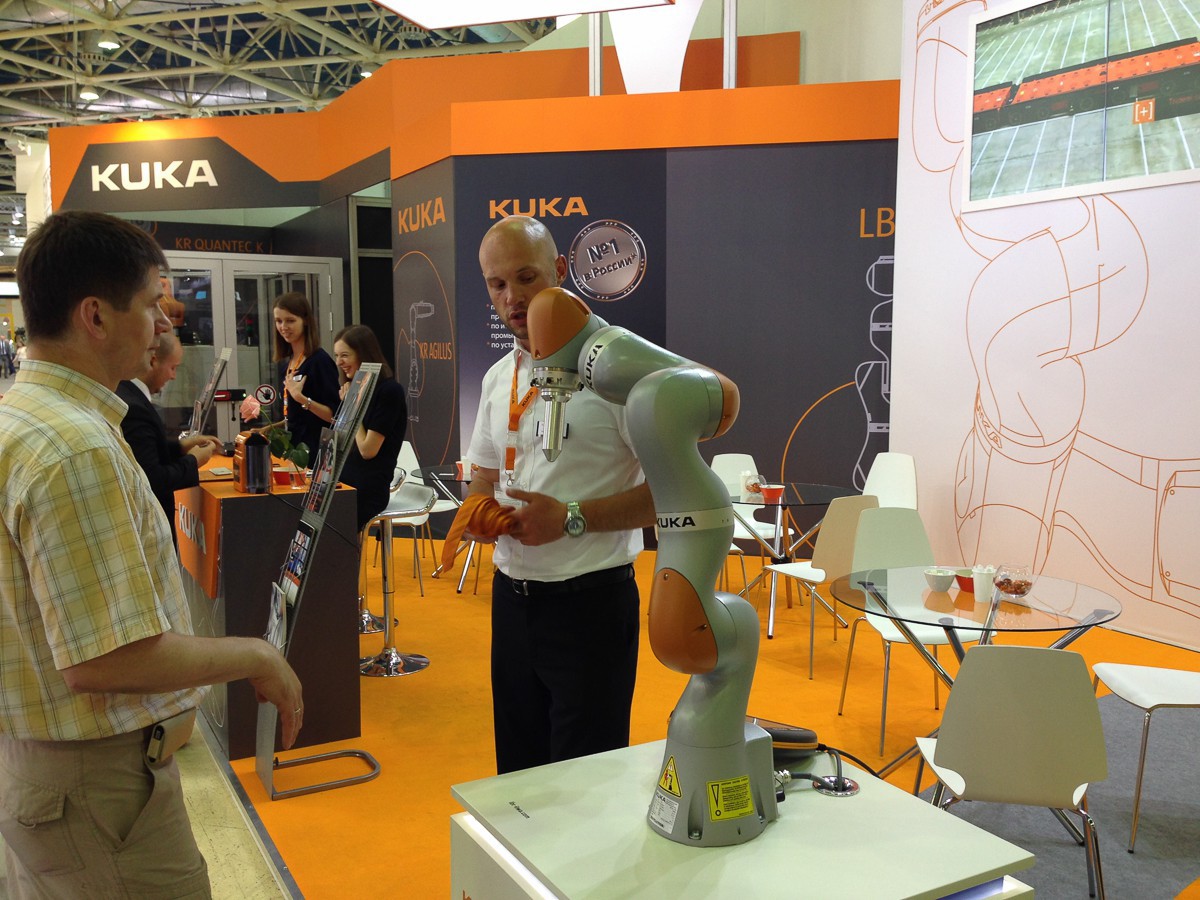
Some companies did not bring their machines at all. They did not bring them to the exhibition:
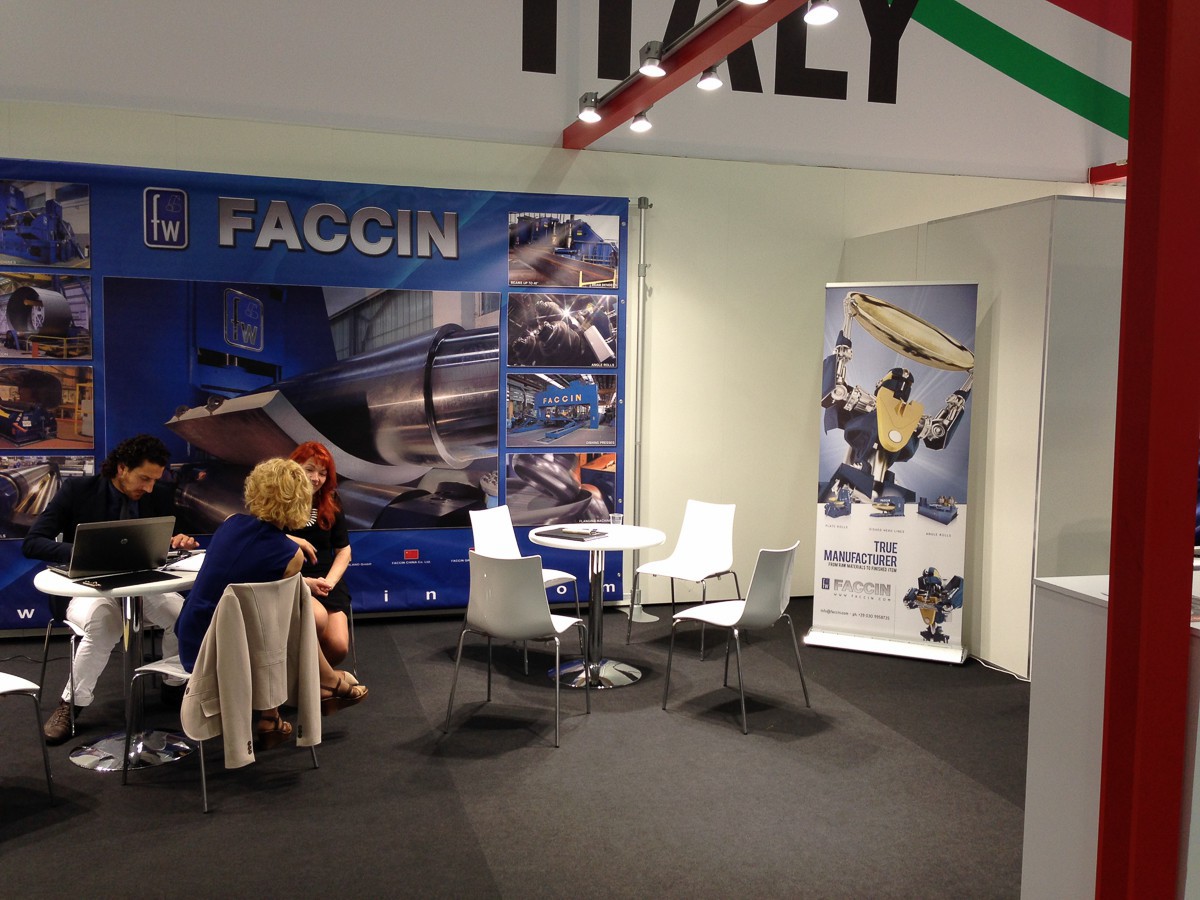
Why all? Because only the products of these machines fit the stand, and the machines themselves would have to be left outside:
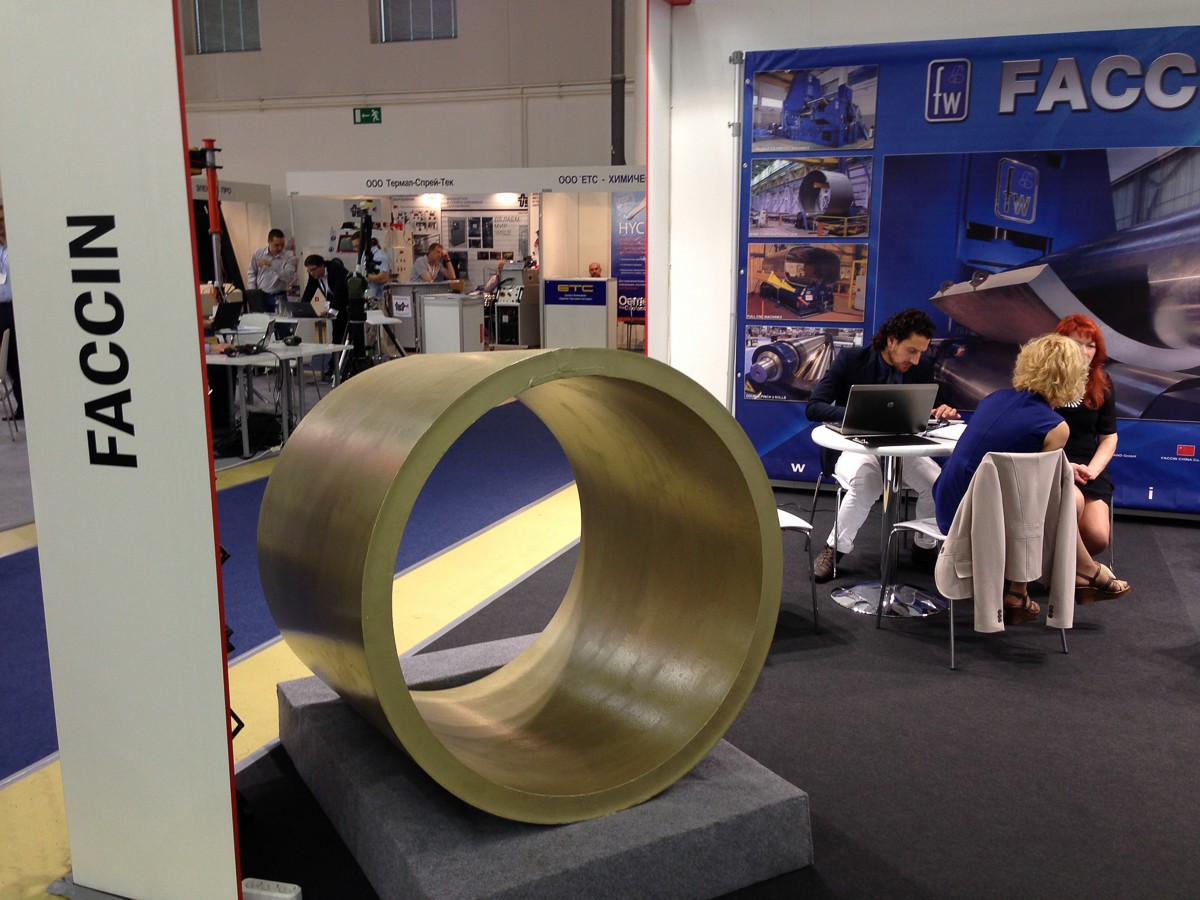
At other companies, the products still got on the stand, albeit with a small creak:
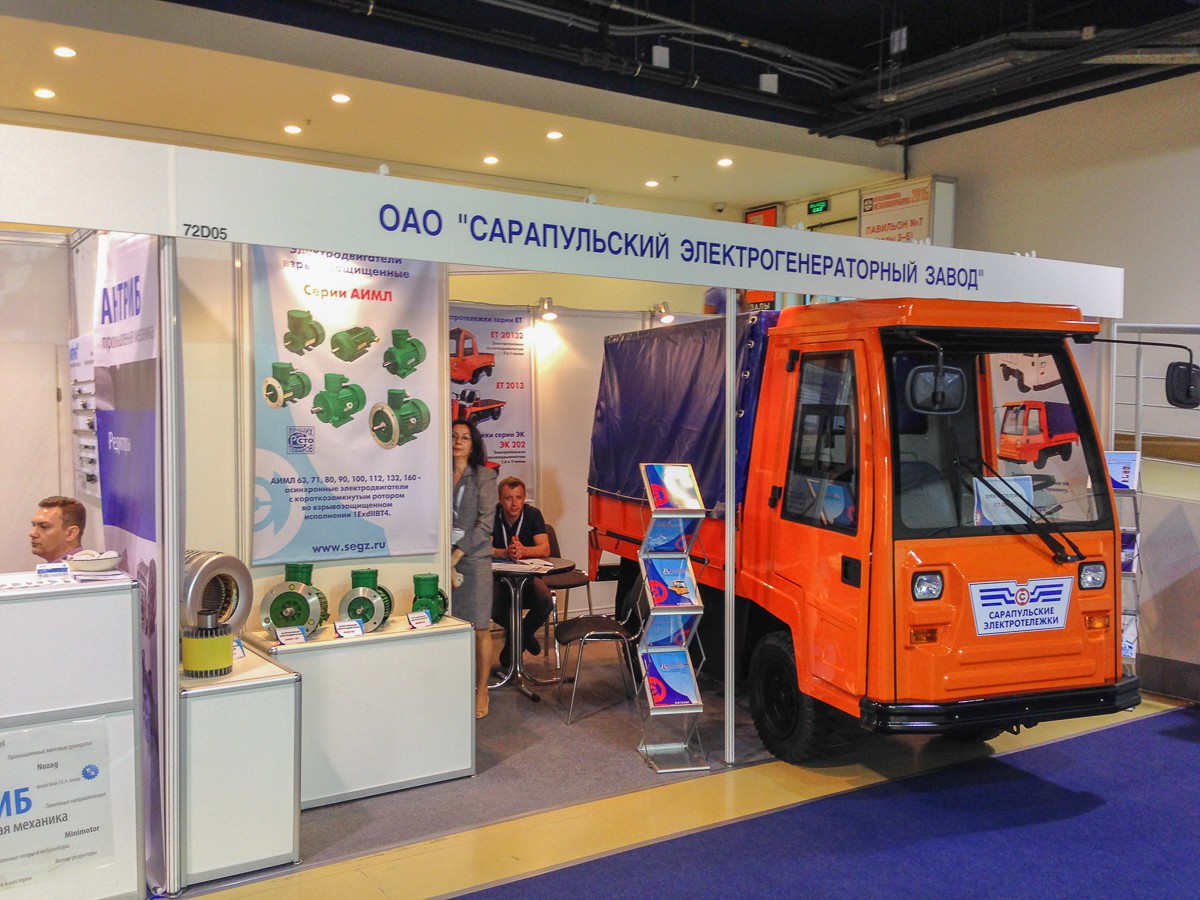
I believe that they had to shorten the name and call the car "Sarapulka":

Many exhibits were intended for post-processing of metal parts. For example, such a tricky abrasive joke for grinding teeth with very high accuracy:

The whole trick is that the entire surface of the spiral passes through each section being processed, and the abrasive also wears from the very beginning, and the last sections (and especially the final section consisting of a thinner abrasive) retain their geometry much longer, providing the same correct geometry of the workpiece.
Or here is such a nice brush for steel pipes, cleaning the burrs and traces of processing:

With such a serious booklet telling about him so much that I want to buy it right here at the exhibition.
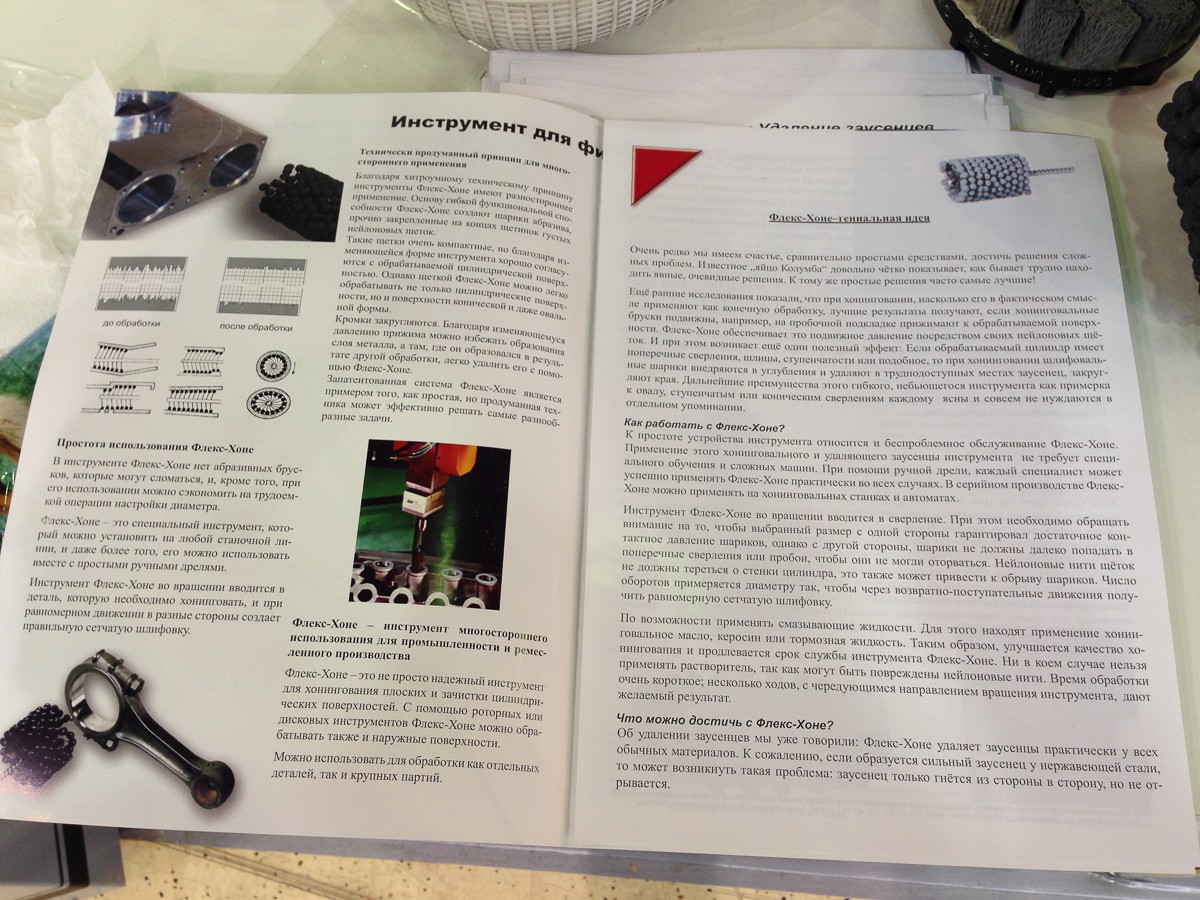
But some companies are creative in displaying their product range:
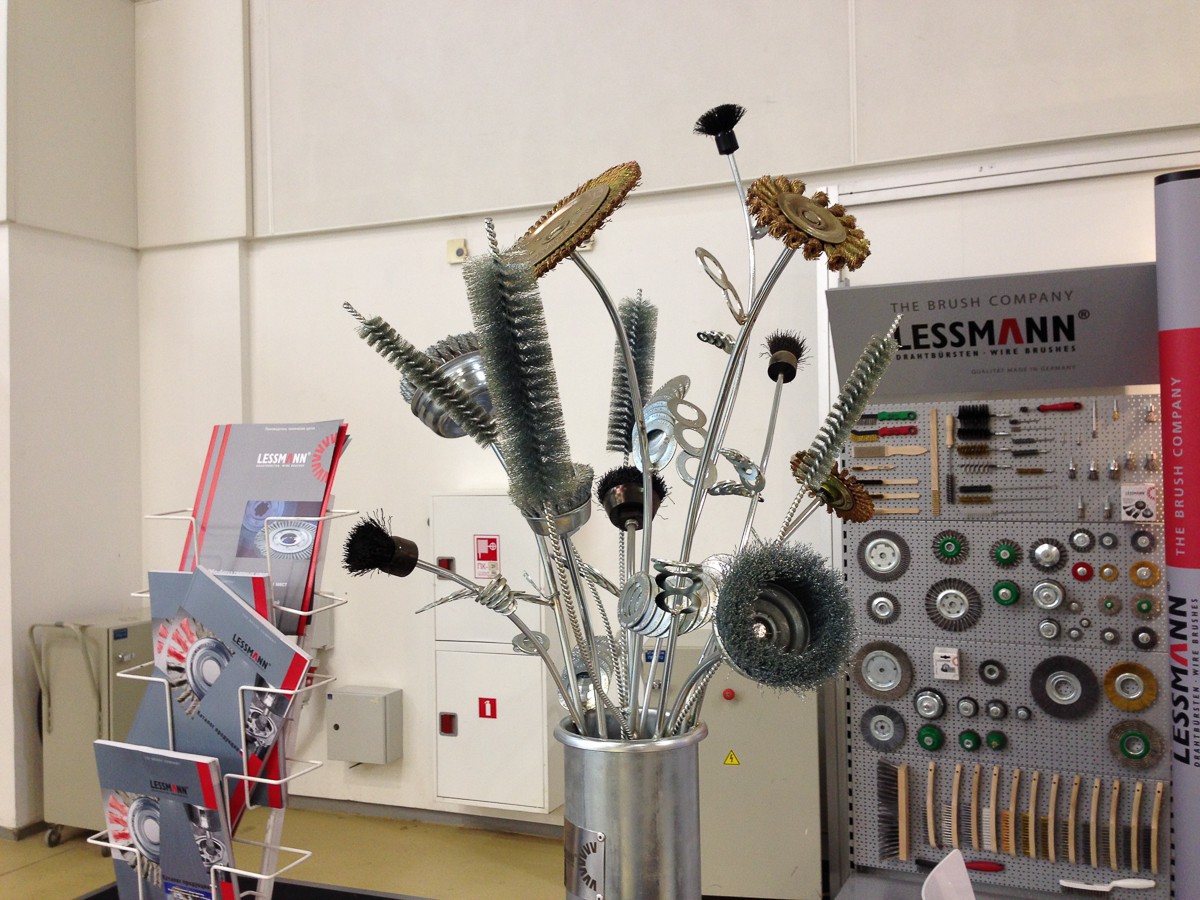
But enough about the colors. Quite a common task - the processing of metal parts with a complex surface to shine. Or not to shine, but simply remove the burrs and dirt. Of course, you can put a person with GOI paste and a toothbrush (or a file) next to it, but this is a rather expensive method that you can seriously apply, perhaps, only in the army and prison. Correct posony use tumbling . The part is loaded into a special drum full of abrasive particles, after which the engine is turned on, which mixes this mass with vibration:

Absolutely sticky sight. The abrasives themselves (they are called tumbling bodies) come in completely different shapes and sizes — the choice depends on the desired degree of processing, the surface and material of the part, and many other factors:
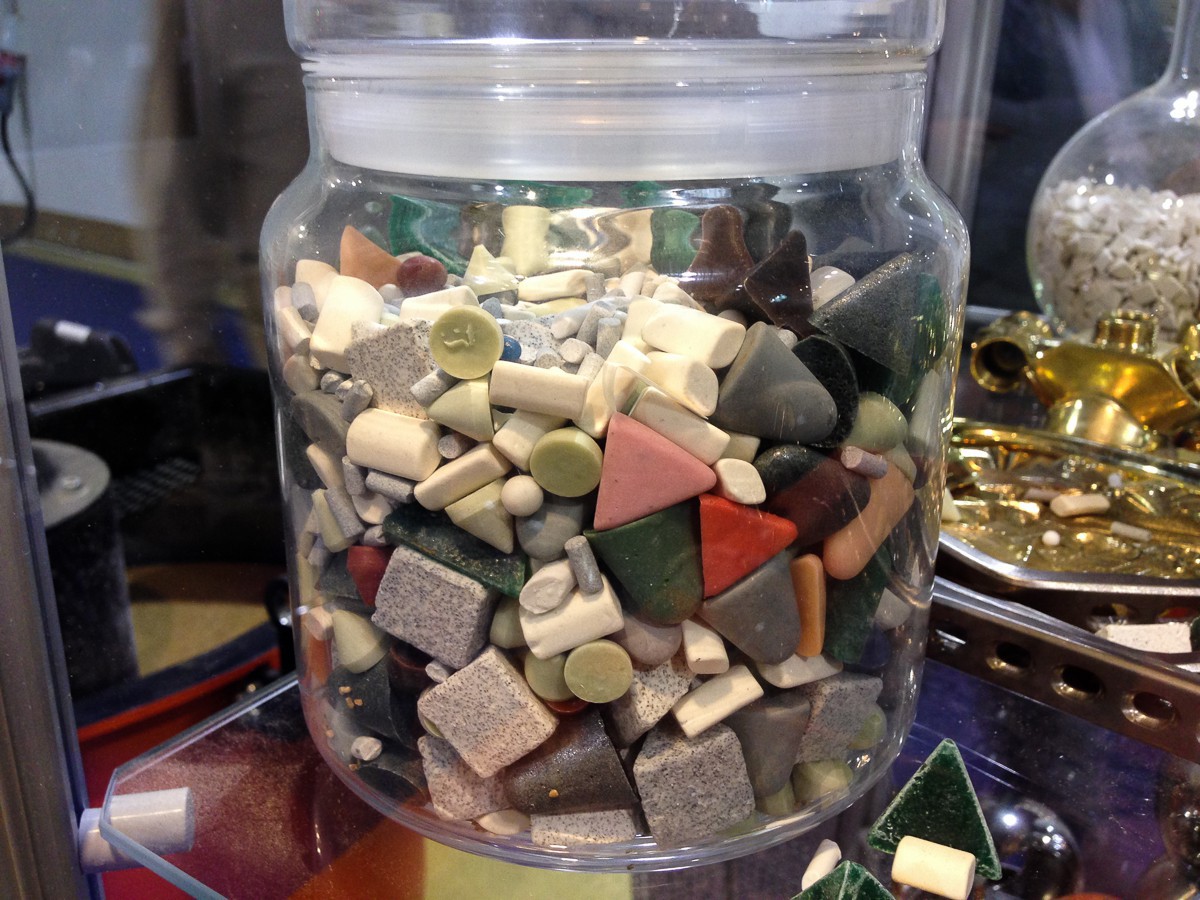
Large sizes are used to smooth the surface, small - for finer polishing:

For example, like this:

Here you can see the difference between the parts before and after processing (in the center is the intermediate stage):
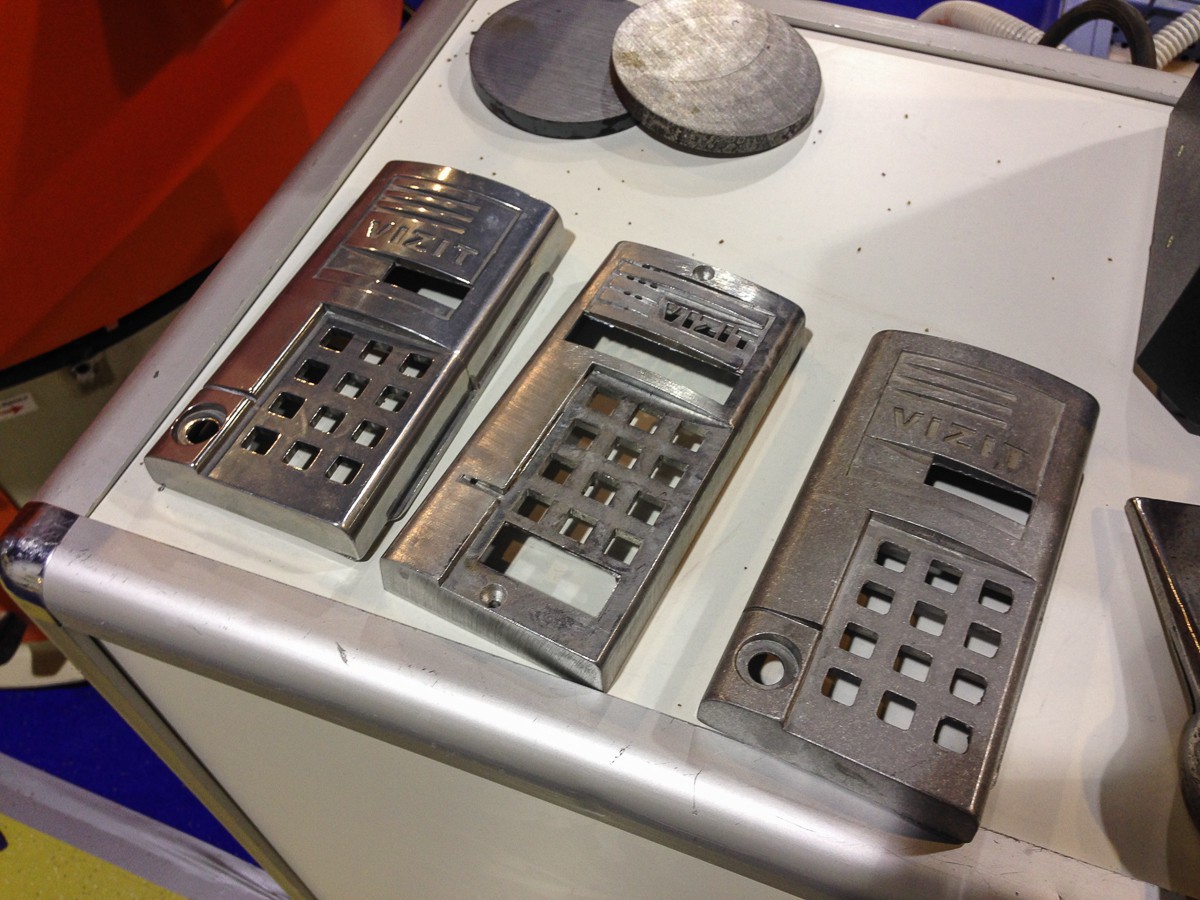
Returning to the topic of lasers, one can say that they are capable of not only cutting metal, but also making more subtle work. For example, a relief that is difficult to achieve by milling:
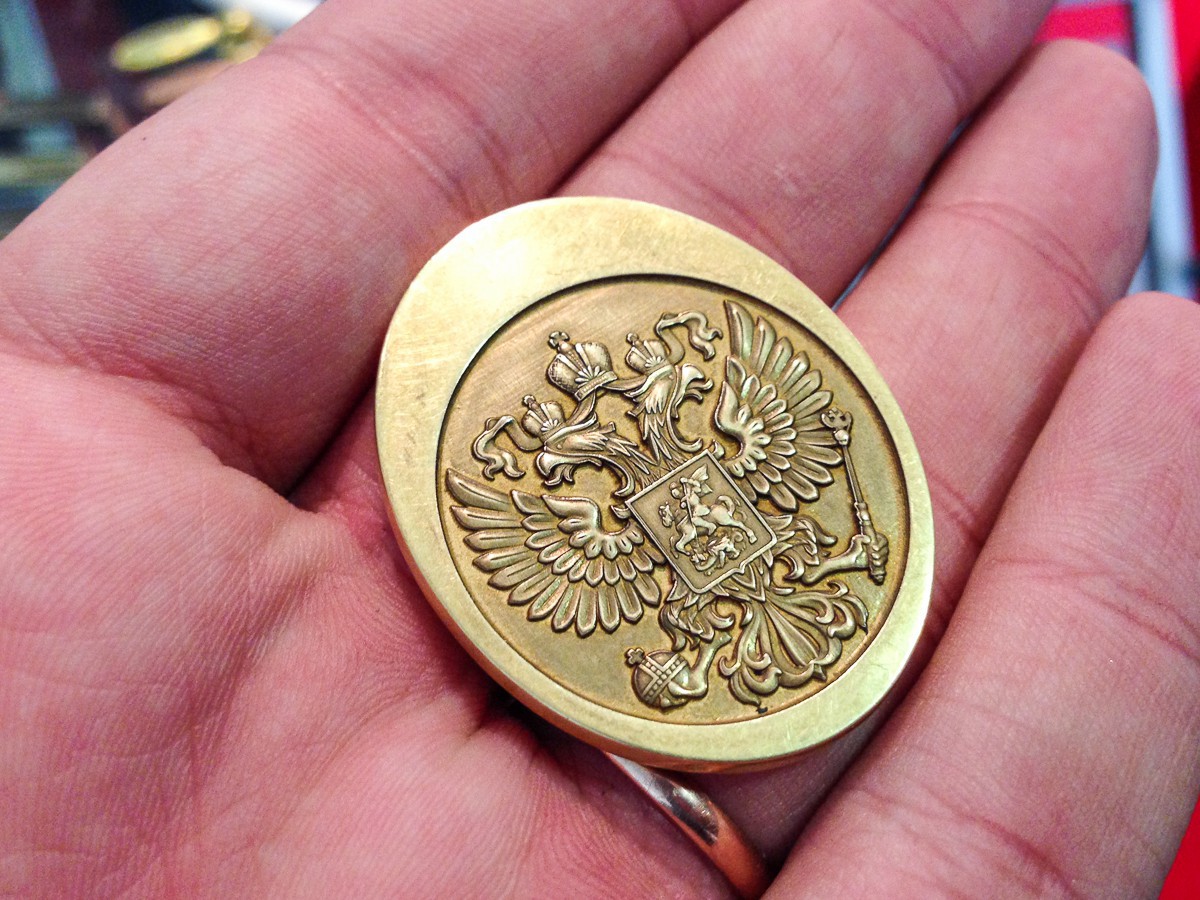
This machine does this:
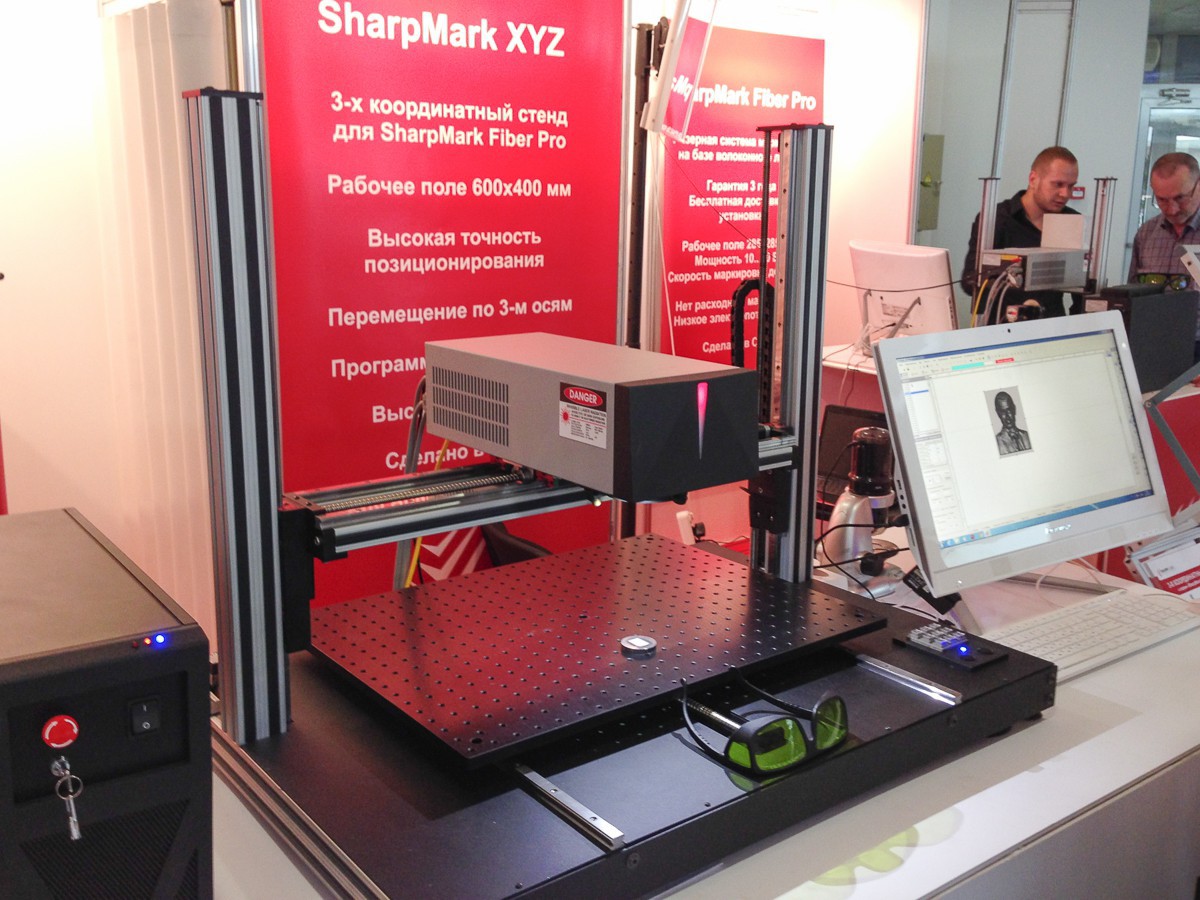
Another, similar, can quickly apply labels:

Once and plaque marked:
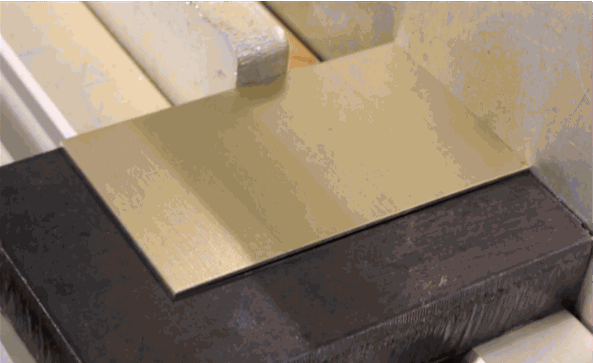
Or not a plate, but the back cover of the phone:

Or do not waste your time on vulgar drawing on the phones, but do something more useful, such as stents for vascular surgery. Pay attention to the match for the scale and estimate the size of this piece:
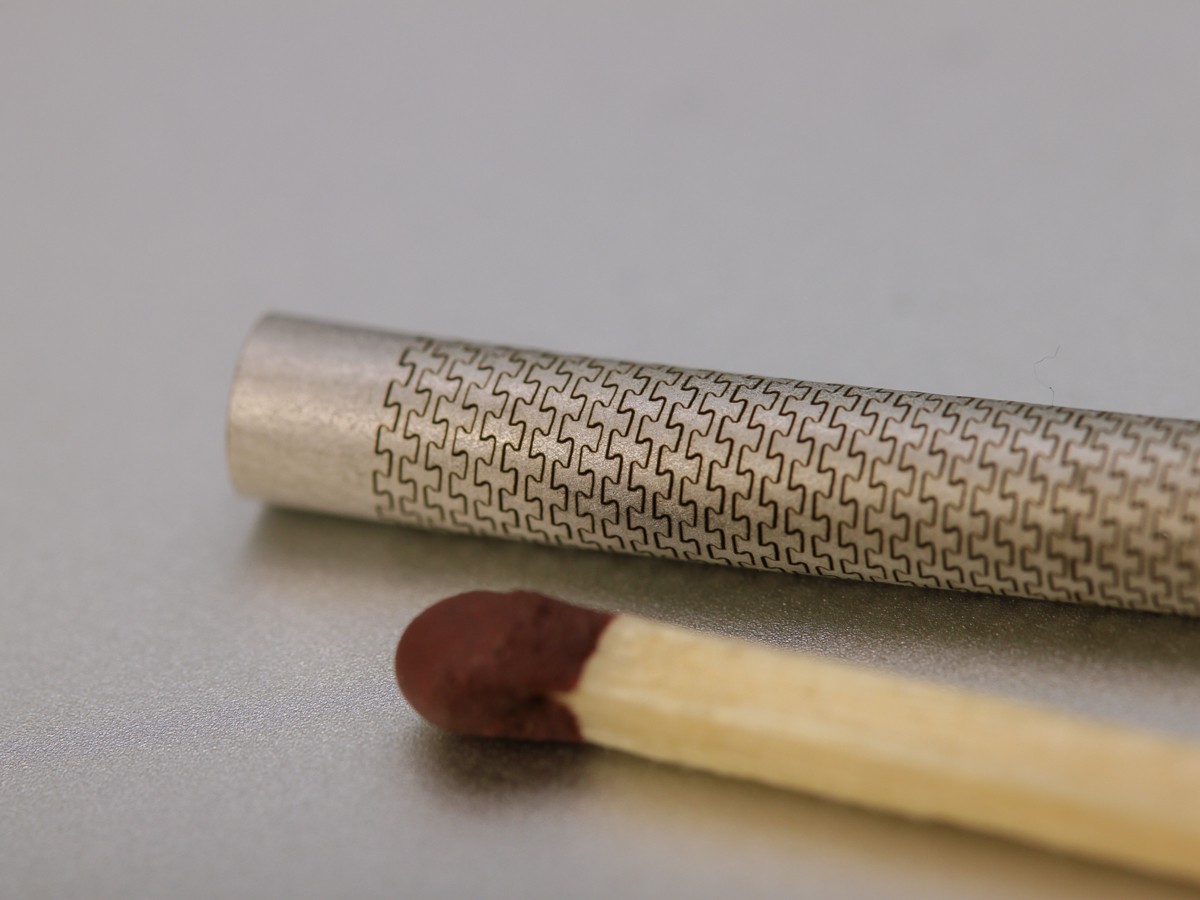
Separately, I would like to note “Minimarker”:

Due to cunning technology, they are able to form a color image on the metal (though not at all):
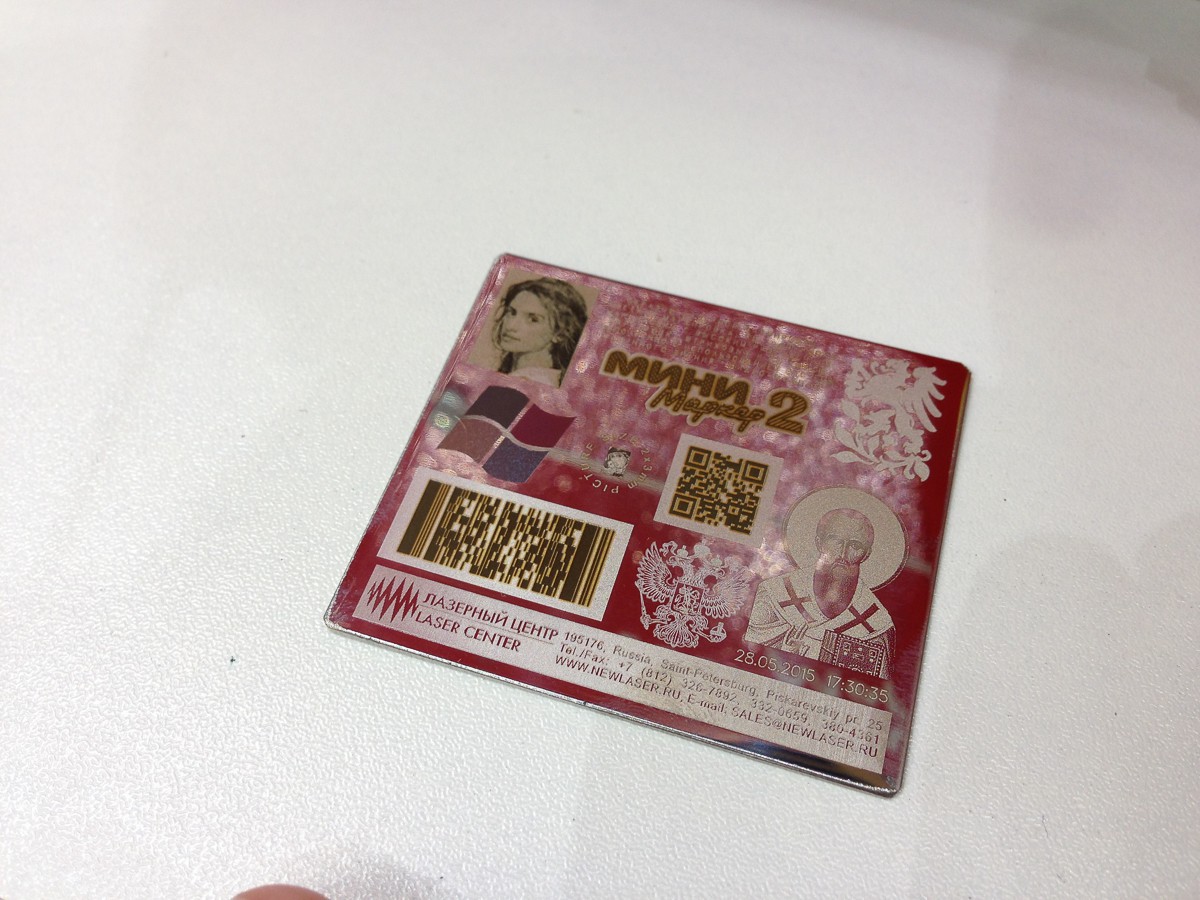
And the mobile version (such a red gun in the center of the frame) is intended for marking with code or inscriptions of large parts in production:
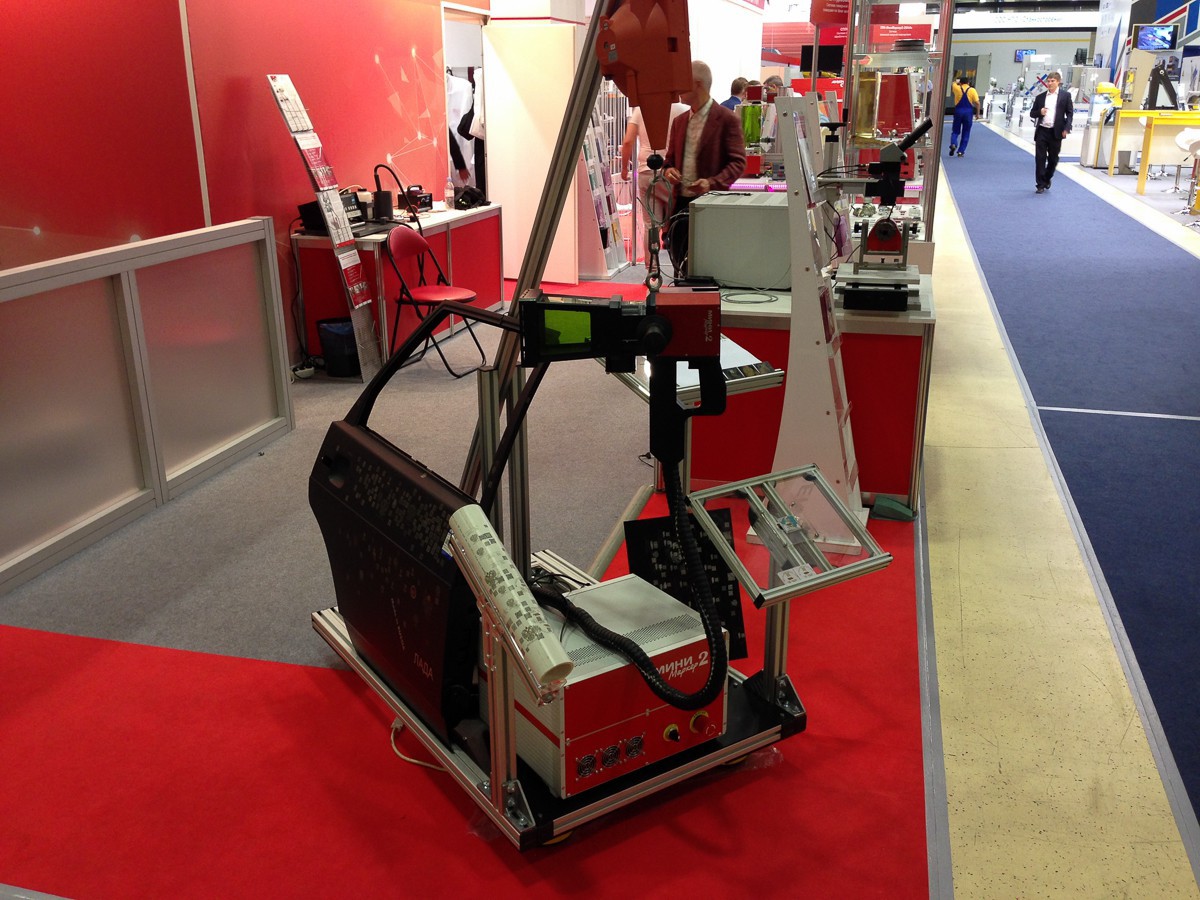
It looks like this:
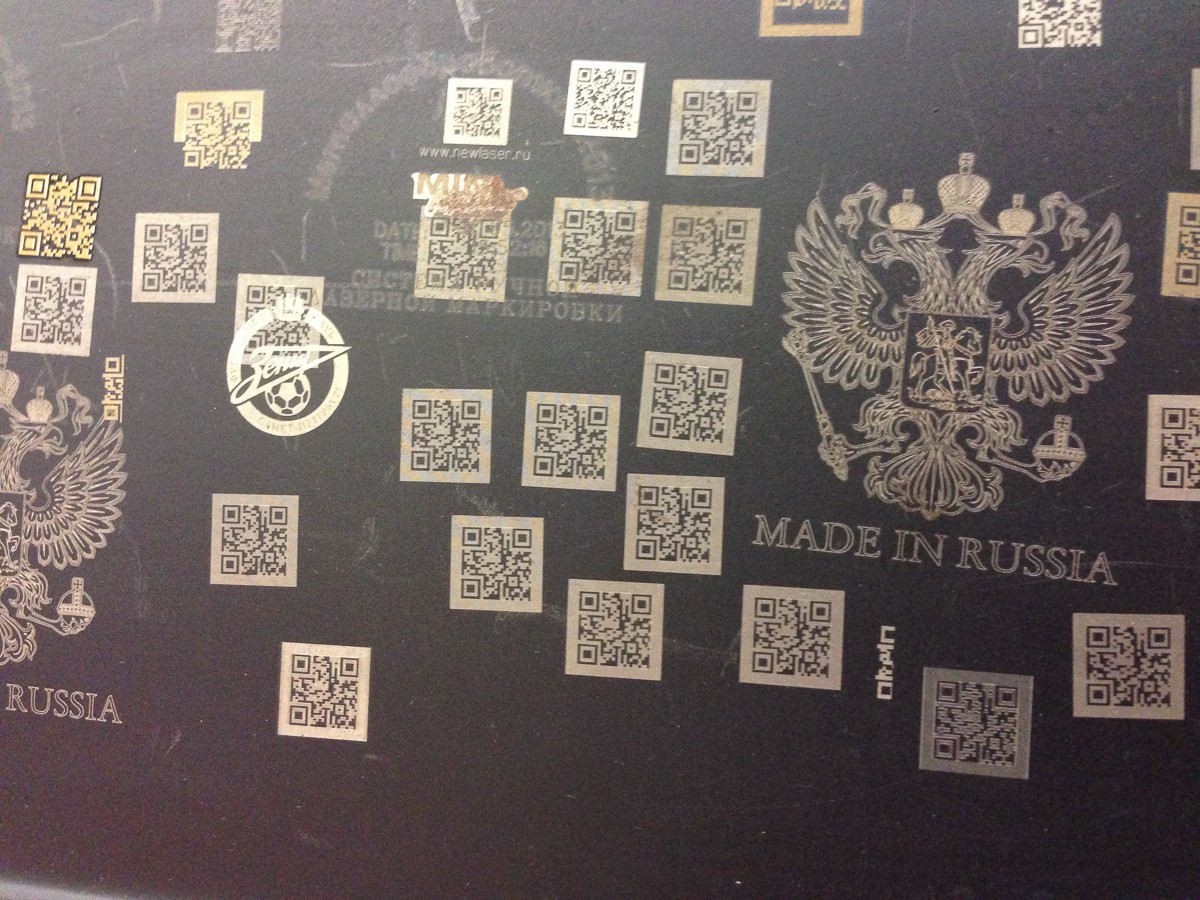
Unlike other types of marking, this method does not require consumables, it is very fast and very durable.
Another way of marking is cheaper - shock-point marking, which, by the principle of operation, resembles a dot-matrix printer, only beats with needles not on the painting ribbon, but on the part itself or on the type plate. The very “needle” looks like this:
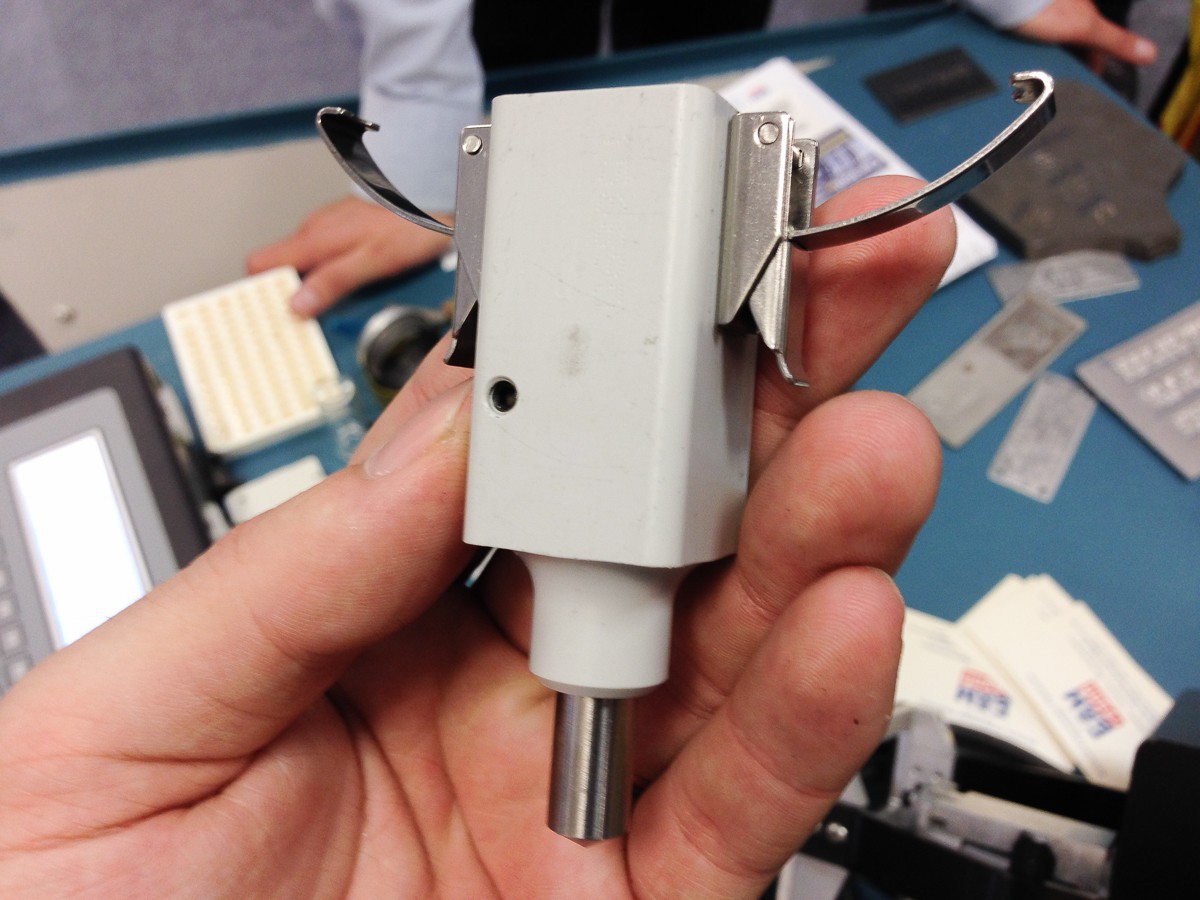
This is how the marker itself:
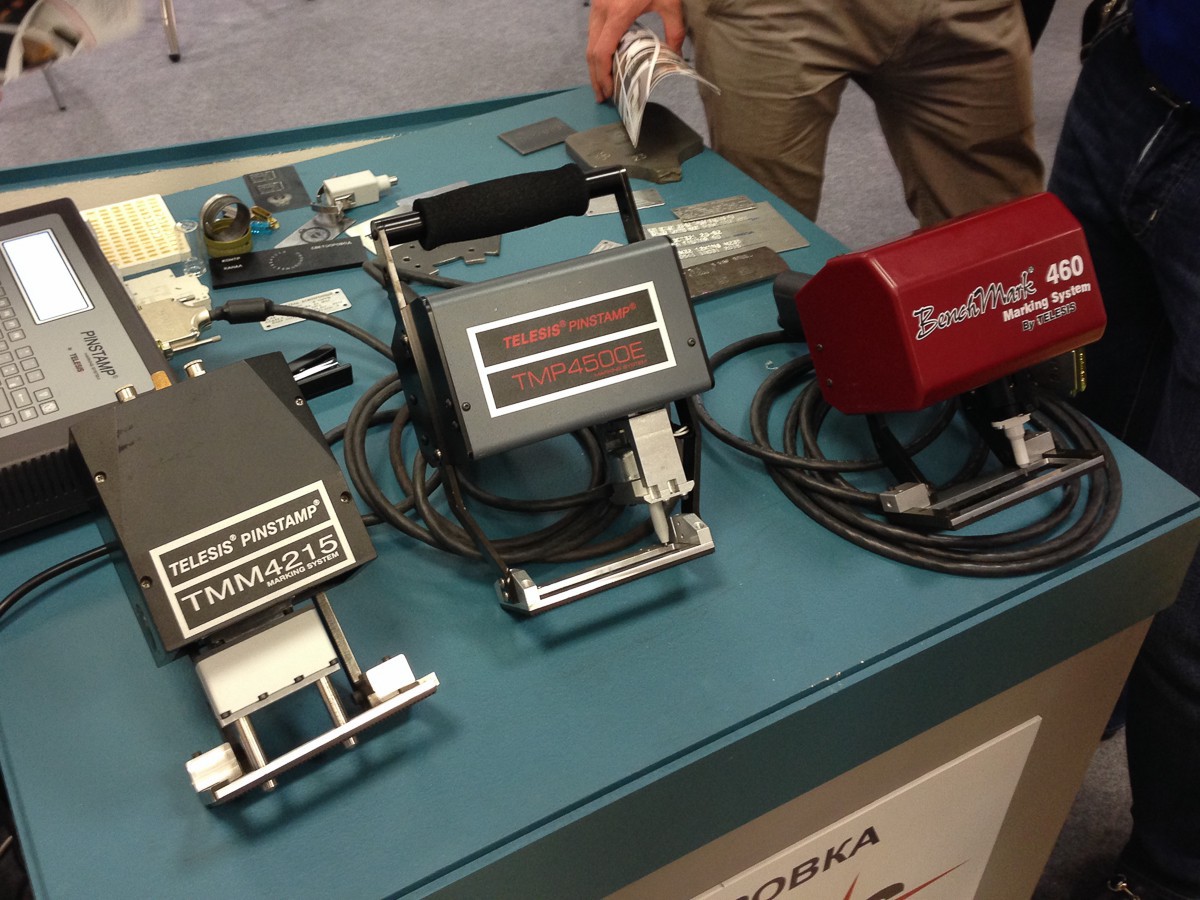
And so the control panel for him:

Using the control panel, enter the desired text, the marker is pressed against the details ...

Done:
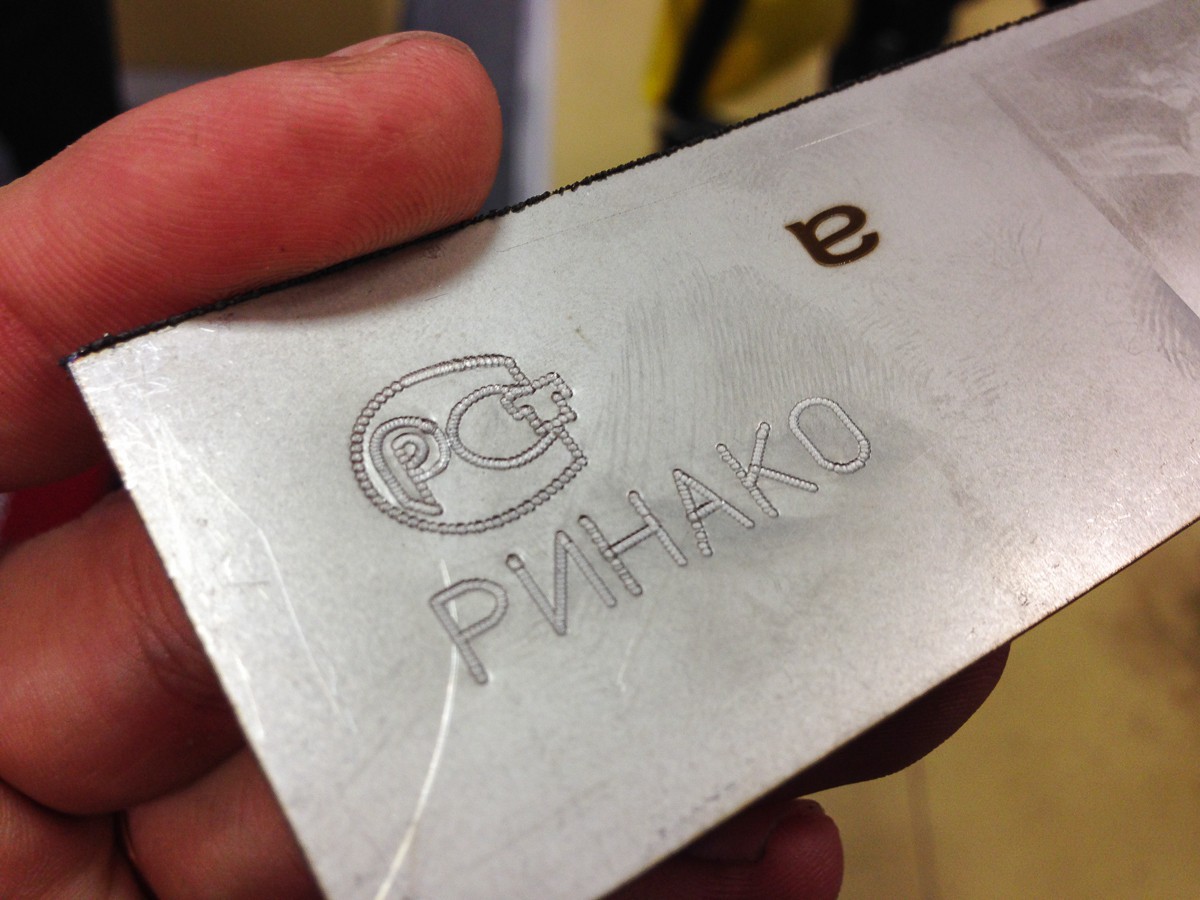
Head drive - pneumatic or electromagnetic. Pneumatic is more powerful, but requires a compressor in the immediate vicinity.
Another interesting technology is the spraying of metal powder using its acceleration to very high speeds with the help of such a thing (also, by the way, our production):

Take a metal plate:
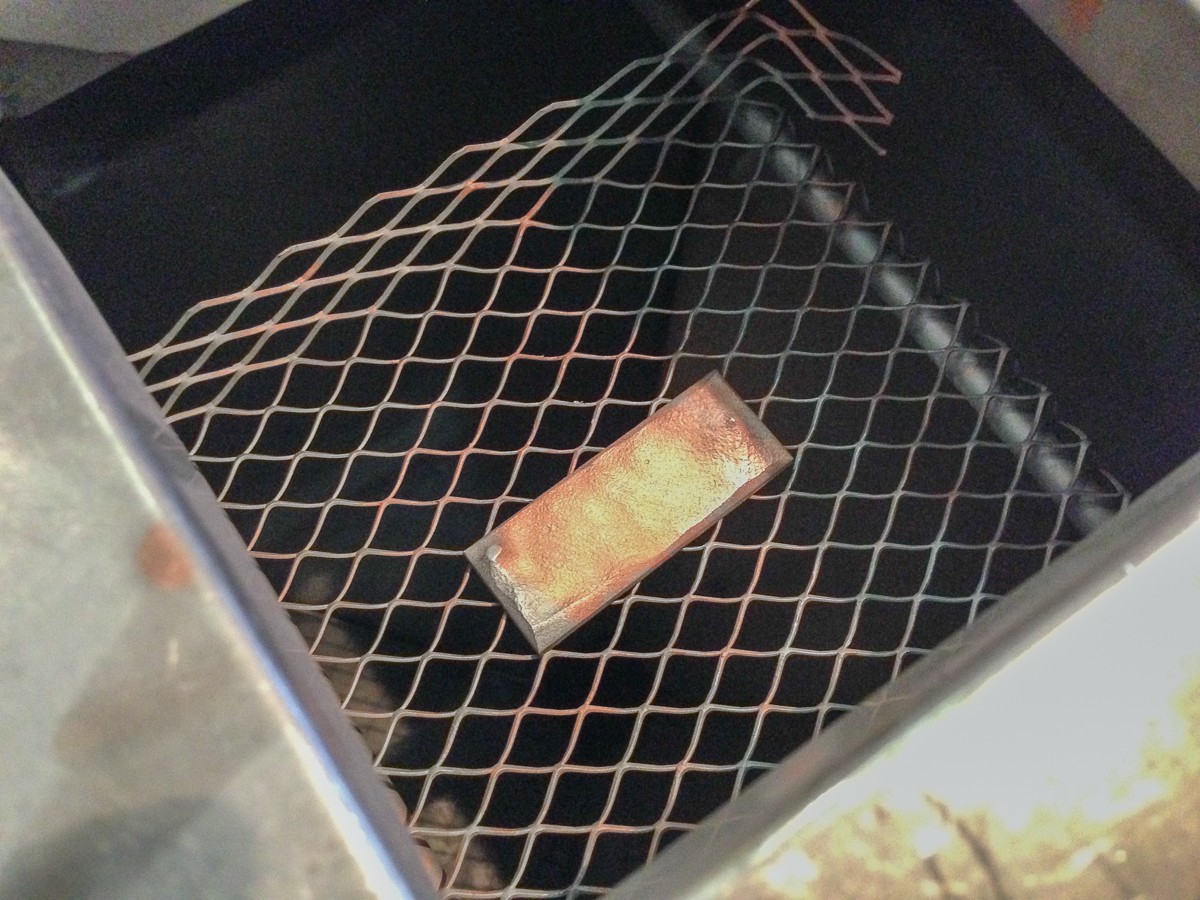
A nozzle is sent to it, and the button is pressed:

And oops, in a few seconds a hillock of metal grows:
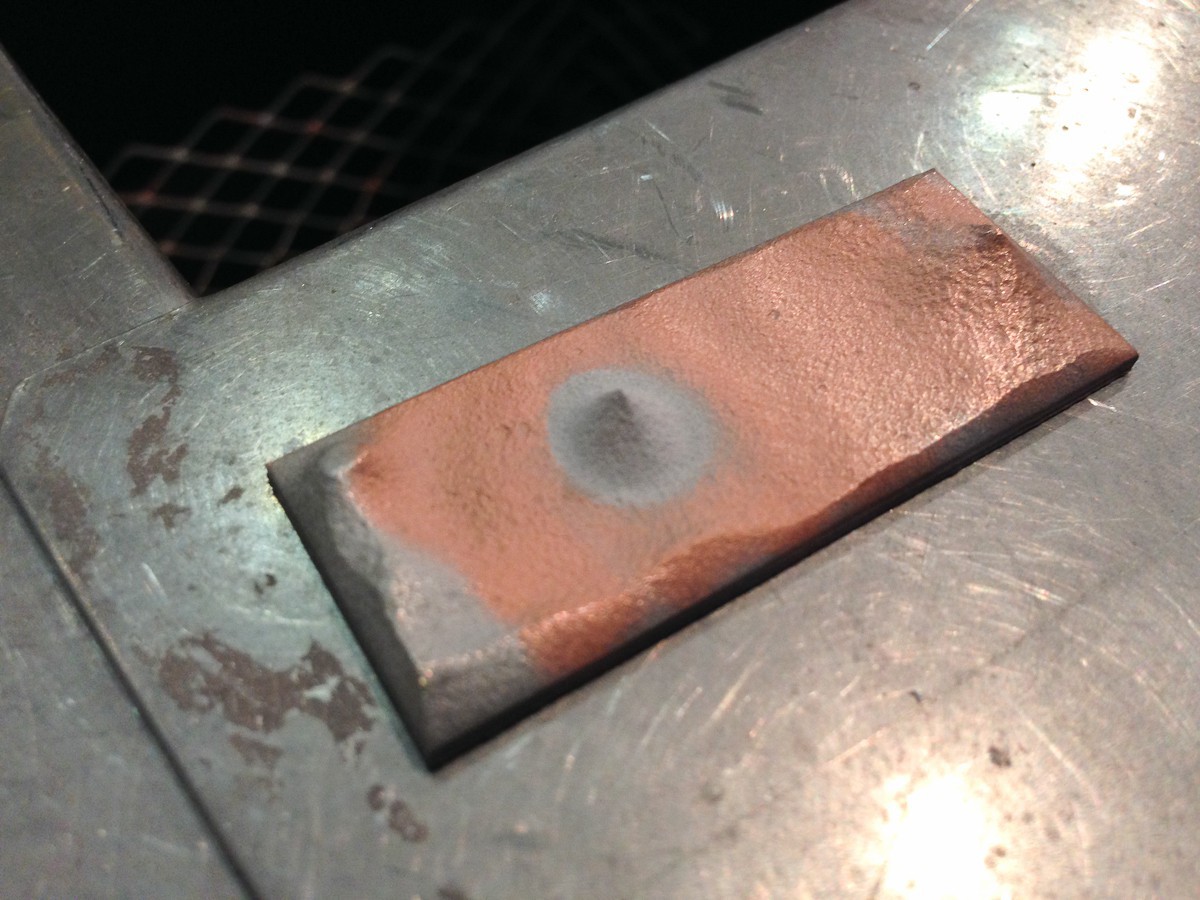
Of course, the hardness of the metal applied in this way is much lower than that of, for example, welded metal, but this method is simple, fast, does not require post-processing, and provides tightness, which is often sufficient.
A big plus is that you do not necessarily need a metal substrate - metal particles accelerate to such a speed that they stick to anything - from glass to plastic. Here, for example, conductive tires on glass:
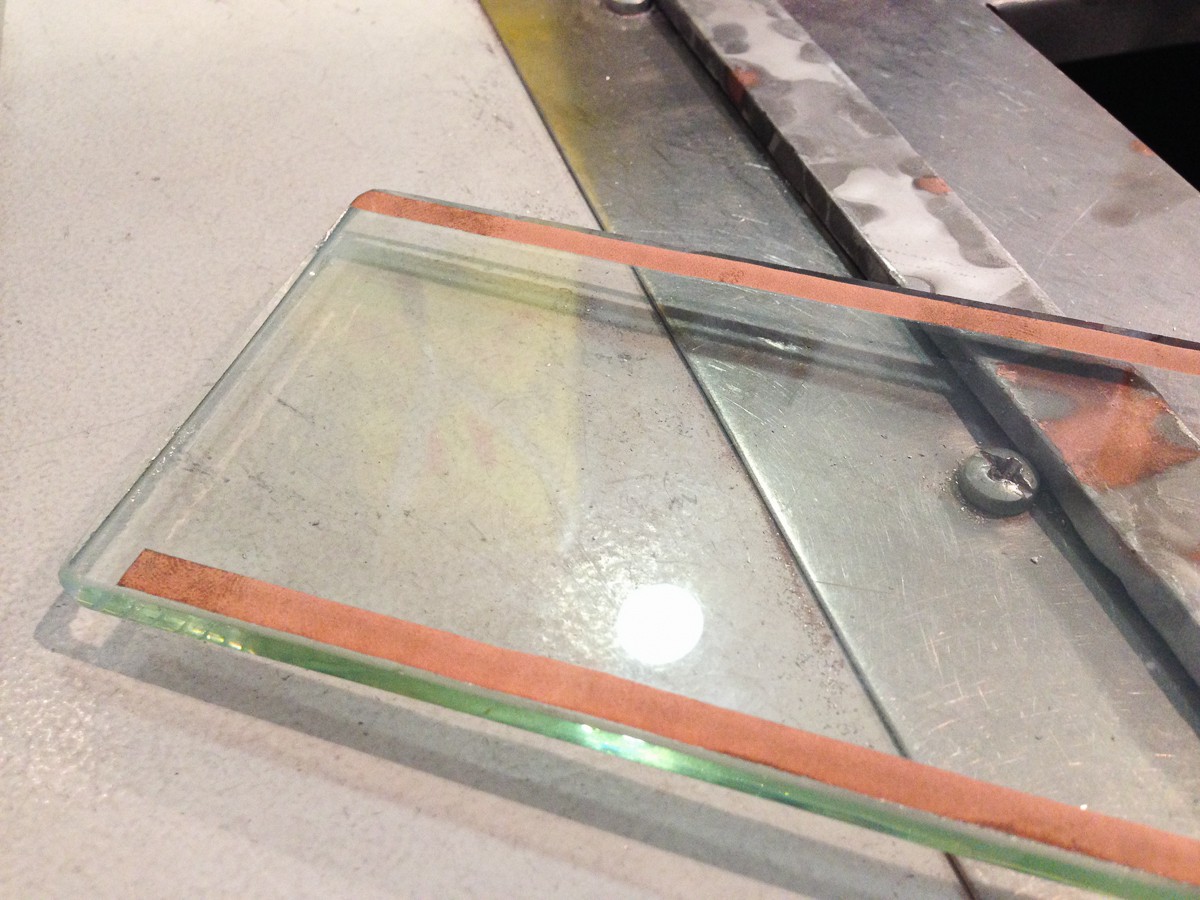
Moreover, two-component - the first coating with aluminum, and the second - with copper. Specifically, in this case, they are needed to connect to a transparent coating on glass, to which it is quite difficult to ensure good contact by conventional means — one has to use long pressure contacts or conductive glue. And you can simply solder to a copper coating or cuddle at one point - the low resistance of the metal allows.
Another Russian company produces a compact spectrometer to determine the composition of the metal. And it is really small - it fits easily on a small trolley:

I did not even regret the blade of my multitool (Leatherman Squirt ES4) to look at the process. It looks like this. First, the sample is cleaned with sandpaper:
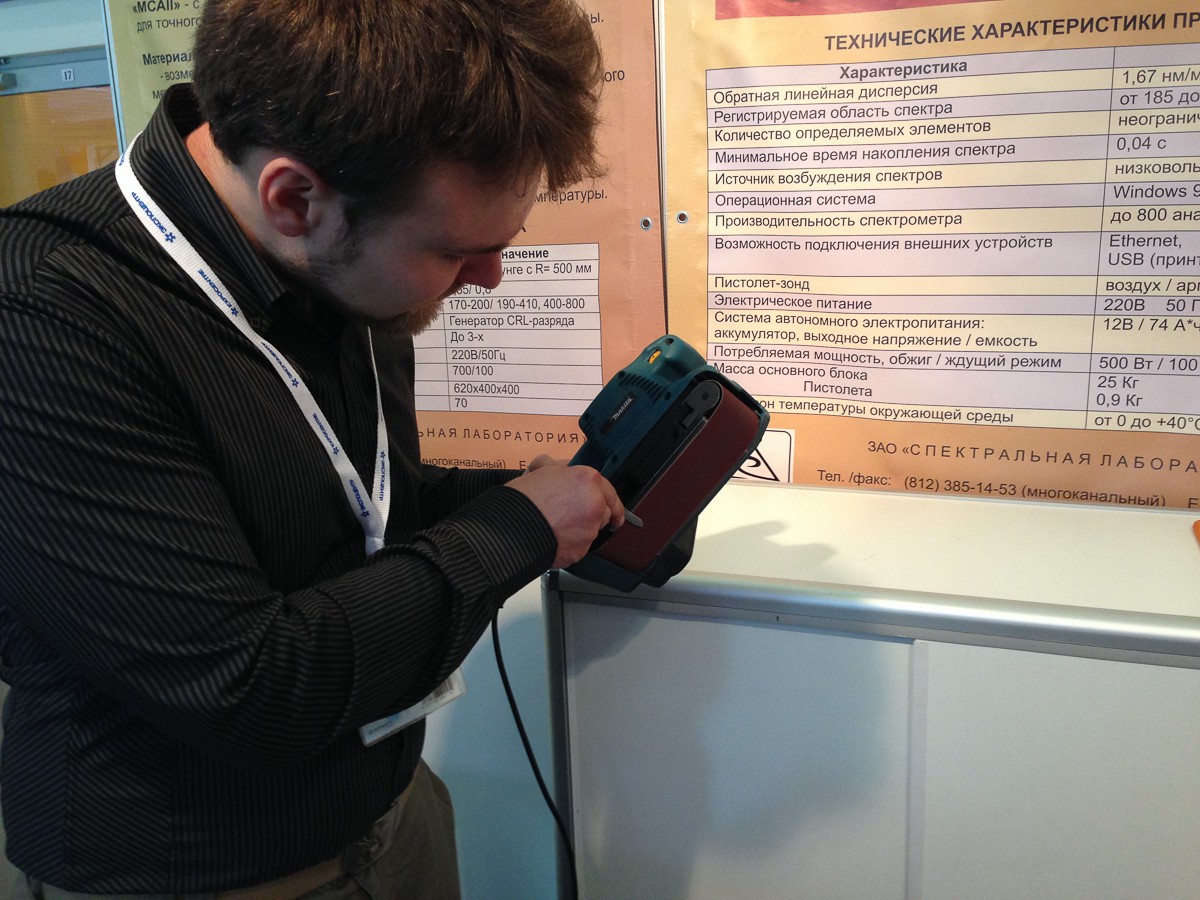
Then tightly pressed against the working chamber:

Due to the small width of the blade I had to go for some tricks:
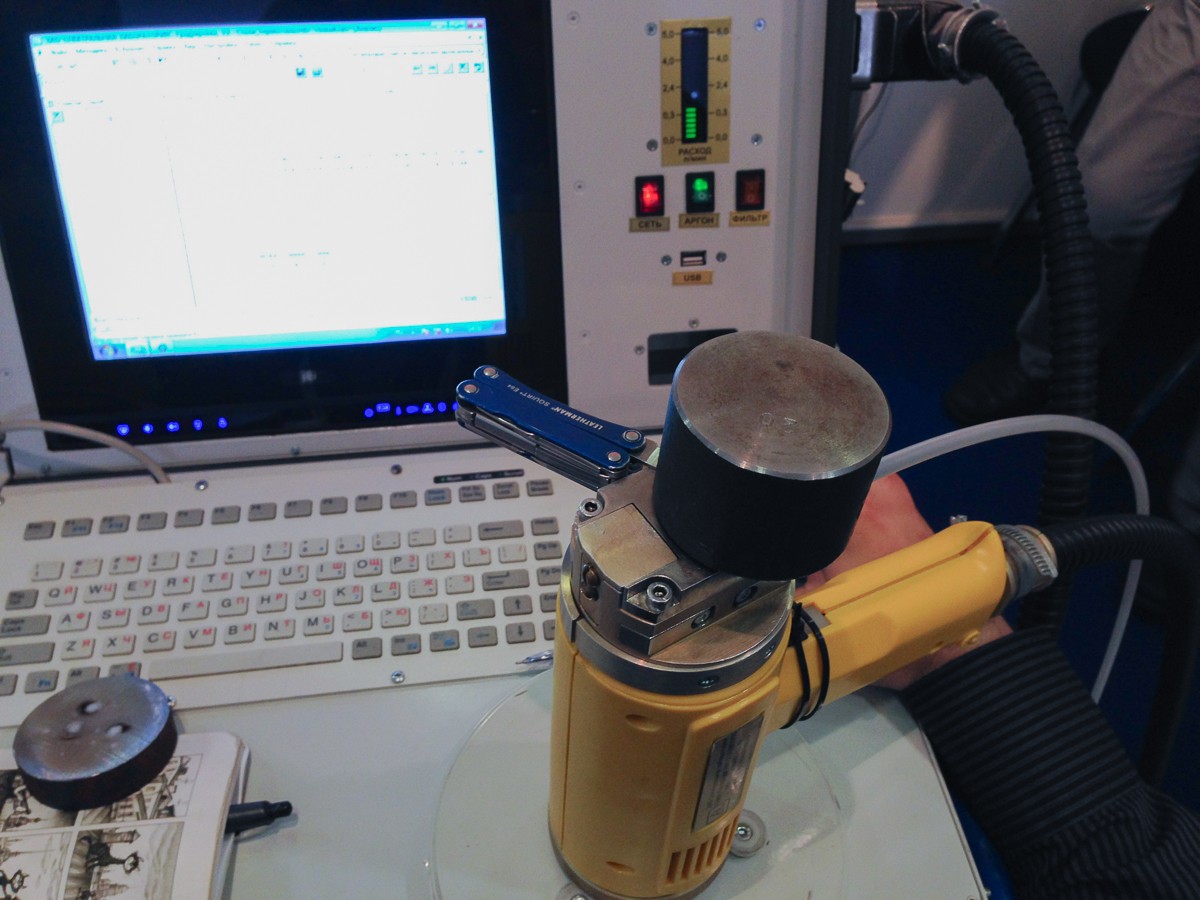
Turns on the gas supply:

And the magic happens:

Just kidding In fact, the magic does not occur - solid physics. The electrode in the working chamber hammer the sample with pulses, creating an arc that tears off the metal particles, causing them to evaporate, and the metal atoms to become excited. In such a state, they cannot stay for a long time, after a short time turning into a normal state, but emitting photons, which are recorded by the CCD. The energy of the emitted photons for each metal is different, which means that you can see how many samples a particular metal has by how many photons each wavelength is caught by the matrix. The spectrum graphically looks like this:
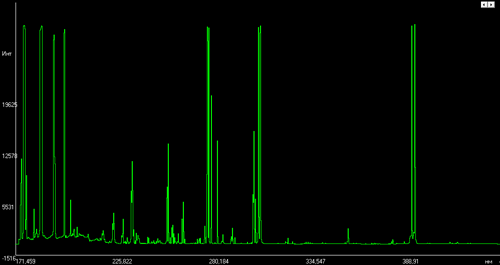
You can read more, for example here .
And here are the results of the analysis of the alloy from which the blade is made:

0.4% carbon, 13% chromium, silicon, nickel, tungsten, molybdenum ... The program automatically tries to choose the most suitable steel grade, in this case it is 4013 according to the Russian classification:
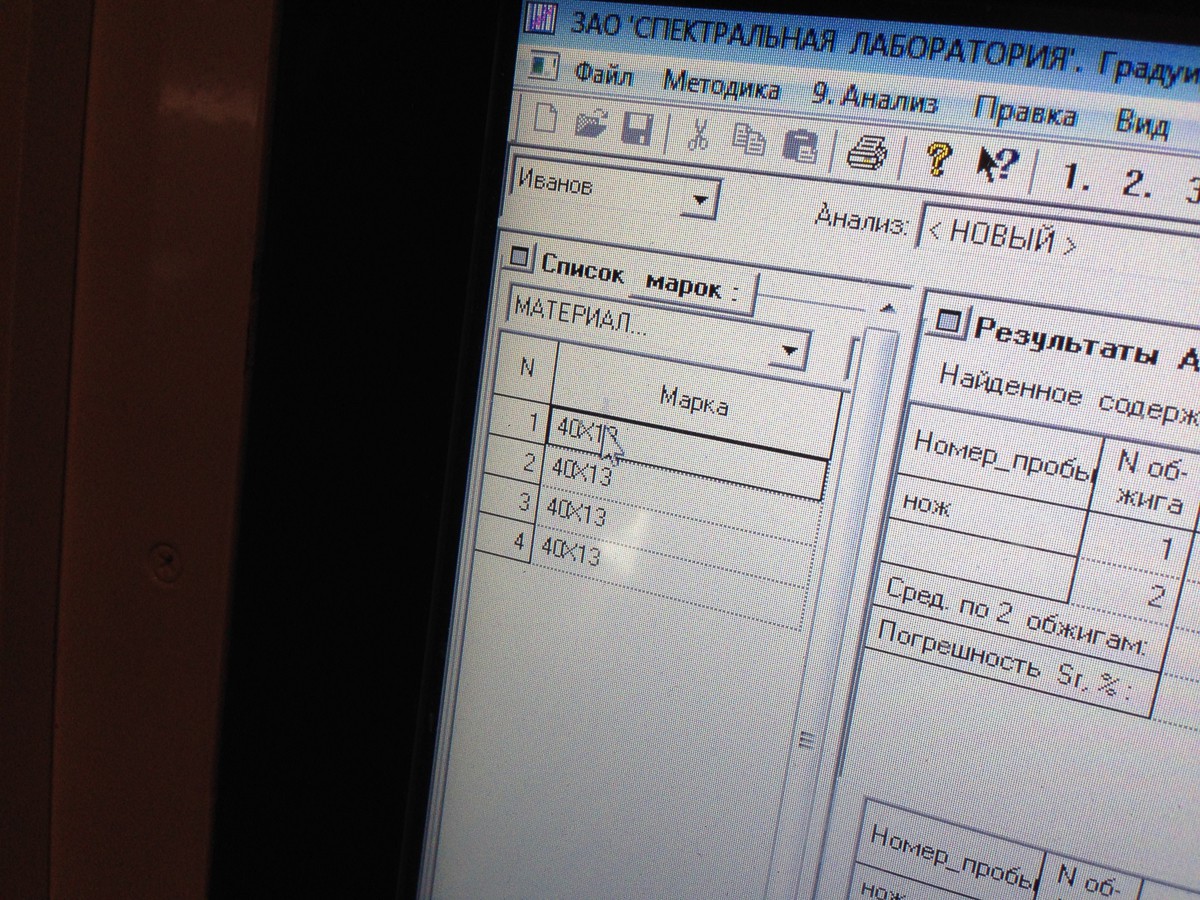
Finally, I'll show you some interesting devices. For example, a scanner that can accurately determine the dimensions of a part:

It is enough to put it on the desktop:

Or profile meter, which with great accuracy determines the amount of roughness of the part:

And displays a graph similar to a cardiogram:

That's all. Good luck in the metalwork, see you next year!






This time we visited all 7 pavilions, and therefore one part, along with gifs, weighs almost 50 megabytes.
Comrade! Be careful with the traffic going under the cat!
')
This is the second part of the article. Read the first part here.
So, we continue.
In the process of metal processing, waste arises - metal shavings and spent coolant. And for this and for the other, there are solutions - compactors for chips:

Which make it such nice metal pills:

And liquid cleaning stations that allow you to reuse water from anything, rather than waste it:

You can also reduce the amount of waste - for example, using an airborne lubricant:

This automatic machine mixes oil with air and, under pressure, supplies it to the processing site, seriously reducing oil consumption and improves cooling.
But a fun simple mechanism that serves to collect oil films from the emulsion surface:

It is based on the fact that a cloth glued into a ring, slightly wetted with water, but well - with oil, is continuously pulled through the emulsion. When the canvas passes through the layer of oil, it sticks to the surface, and at the top it collects from it with a sharp edge and flows by gravity into the oil compartment. Simple and elegant.
Now let's talk not about cutting, but about the connection of metal. For example, about welding. Here, for example, automatic machine for pipe welding:

How to cut the pipe, I already showed you. And this is how they are welded:

If the pipe is so large that there is no possibility to locate the machine around it, or if it is not a pipe, but just a curved part, then the Sunrise automatic welding kit comes to the rescue:

It is attached to the surface with magnets (or with the help of vacuum suction pads for non-magnetic materials):

And absolutely automatically (including transverse movement along the seam and axial oscillations of the burner) welds two parts:

It turns out such a beautiful seam:

Of course, automatic welding machines were also shown:

For example, these can boil almost any metal in any gas mixture:

And this welder can weld bolts and nuts to metal surfaces:

A special bolt is inserted into the working head (it is distinguished by an almost total absence of a cap and some kind of special coating):

The tool is pressed against the metal sheet and the button is pressed:

Here you can see what happened as a result:

This is a device for proper sharpening of electrodes for argon-arc welding:

If amateurs get along with a screwdriver and a Dremel, then professionals use special devices in which the electrode is always sharpened at the right angle.

If a part is really a complex shape, then automatic welding is performed using one or several manipulators:

In general, manipulators can do a variety of things. Turn over parts:

Serve them:

Download to machine:

To mill complex shapes:

To play air hockey:


Pretend mime (you can watch the video here (by the way, subscribe ):

And even sort the details:

Here is the thing that puffs red - the camera, with the help of which the robot understands which side has the part turned to it, and depending on it puts it on one or the other side. Another camera with a special laser illuminator is located at the top - it is needed to determine the position of the piled parts, so that the robot can grab it correctly.
Another very interesting development of the same company is “High-speed robotic cell for sorting by color”:

It represents such a cute yellow machine that can automatically automatically identify objects of different colors on the working field and sort them according to color, and do it at a speed inaccessible to humans:

Once, once, once and ready:

In fact, he does it faster than on the gif. The real speed can be seen here (by the way, subscribe ).
It clings and carries objects with vacuum suction cups:

After all three colors are sorted by jars, the robot overturns them back to the working field and everything starts anew:

You can watch forever.
KUKA brought a friendly roboruku, around which there are no signs forbidding to approach it:

And the thing is that she somehow knows how to determine what is being prevented from working and stopping her movement. It looks pretty impressive - the dude comes up to the hand moving at full speed, it bumps into his shoulder and ... nothing happens - the push turns out to be sensitive, but not even knocking him down:

Some companies did not bring their machines at all. They did not bring them to the exhibition:

Why all? Because only the products of these machines fit the stand, and the machines themselves would have to be left outside:

At other companies, the products still got on the stand, albeit with a small creak:

I believe that they had to shorten the name and call the car "Sarapulka":

Many exhibits were intended for post-processing of metal parts. For example, such a tricky abrasive joke for grinding teeth with very high accuracy:

The whole trick is that the entire surface of the spiral passes through each section being processed, and the abrasive also wears from the very beginning, and the last sections (and especially the final section consisting of a thinner abrasive) retain their geometry much longer, providing the same correct geometry of the workpiece.
Or here is such a nice brush for steel pipes, cleaning the burrs and traces of processing:

With such a serious booklet telling about him so much that I want to buy it right here at the exhibition.

But some companies are creative in displaying their product range:

But enough about the colors. Quite a common task - the processing of metal parts with a complex surface to shine. Or not to shine, but simply remove the burrs and dirt. Of course, you can put a person with GOI paste and a toothbrush (or a file) next to it, but this is a rather expensive method that you can seriously apply, perhaps, only in the army and prison. Correct posony use tumbling . The part is loaded into a special drum full of abrasive particles, after which the engine is turned on, which mixes this mass with vibration:

Absolutely sticky sight. The abrasives themselves (they are called tumbling bodies) come in completely different shapes and sizes — the choice depends on the desired degree of processing, the surface and material of the part, and many other factors:

Large sizes are used to smooth the surface, small - for finer polishing:

For example, like this:

Here you can see the difference between the parts before and after processing (in the center is the intermediate stage):

Returning to the topic of lasers, one can say that they are capable of not only cutting metal, but also making more subtle work. For example, a relief that is difficult to achieve by milling:

This machine does this:

Another, similar, can quickly apply labels:

Once and plaque marked:

Or not a plate, but the back cover of the phone:

Or do not waste your time on vulgar drawing on the phones, but do something more useful, such as stents for vascular surgery. Pay attention to the match for the scale and estimate the size of this piece:

Separately, I would like to note “Minimarker”:

Due to cunning technology, they are able to form a color image on the metal (though not at all):

And the mobile version (such a red gun in the center of the frame) is intended for marking with code or inscriptions of large parts in production:

It looks like this:

Unlike other types of marking, this method does not require consumables, it is very fast and very durable.
Another way of marking is cheaper - shock-point marking, which, by the principle of operation, resembles a dot-matrix printer, only beats with needles not on the painting ribbon, but on the part itself or on the type plate. The very “needle” looks like this:

This is how the marker itself:

And so the control panel for him:

Using the control panel, enter the desired text, the marker is pressed against the details ...

Done:

Head drive - pneumatic or electromagnetic. Pneumatic is more powerful, but requires a compressor in the immediate vicinity.
Another interesting technology is the spraying of metal powder using its acceleration to very high speeds with the help of such a thing (also, by the way, our production):

Take a metal plate:

A nozzle is sent to it, and the button is pressed:

And oops, in a few seconds a hillock of metal grows:

Of course, the hardness of the metal applied in this way is much lower than that of, for example, welded metal, but this method is simple, fast, does not require post-processing, and provides tightness, which is often sufficient.
A big plus is that you do not necessarily need a metal substrate - metal particles accelerate to such a speed that they stick to anything - from glass to plastic. Here, for example, conductive tires on glass:

Moreover, two-component - the first coating with aluminum, and the second - with copper. Specifically, in this case, they are needed to connect to a transparent coating on glass, to which it is quite difficult to ensure good contact by conventional means — one has to use long pressure contacts or conductive glue. And you can simply solder to a copper coating or cuddle at one point - the low resistance of the metal allows.
Another Russian company produces a compact spectrometer to determine the composition of the metal. And it is really small - it fits easily on a small trolley:

I did not even regret the blade of my multitool (Leatherman Squirt ES4) to look at the process. It looks like this. First, the sample is cleaned with sandpaper:

Then tightly pressed against the working chamber:

Due to the small width of the blade I had to go for some tricks:

Turns on the gas supply:

And the magic happens:

Just kidding In fact, the magic does not occur - solid physics. The electrode in the working chamber hammer the sample with pulses, creating an arc that tears off the metal particles, causing them to evaporate, and the metal atoms to become excited. In such a state, they cannot stay for a long time, after a short time turning into a normal state, but emitting photons, which are recorded by the CCD. The energy of the emitted photons for each metal is different, which means that you can see how many samples a particular metal has by how many photons each wavelength is caught by the matrix. The spectrum graphically looks like this:

You can read more, for example here .
And here are the results of the analysis of the alloy from which the blade is made:

0.4% carbon, 13% chromium, silicon, nickel, tungsten, molybdenum ... The program automatically tries to choose the most suitable steel grade, in this case it is 4013 according to the Russian classification:

Finally, I'll show you some interesting devices. For example, a scanner that can accurately determine the dimensions of a part:

It is enough to put it on the desktop:

Or profile meter, which with great accuracy determines the amount of roughness of the part:

And displays a graph similar to a cardiogram:

That's all. Good luck in the metalwork, see you next year!





Source: https://habr.com/ru/post/260839/
All Articles